#also the whole song is reminiscent of opening sequence
Text
the outro choreography for devil by the window actually showed me the gates of heaven
#no lies were told#soobin rising from the ground like a fallen angel#yeonjun having is michelangelo painting moment on top of the other members#SOOBIN SOLO!!!!!! YES#reminded me a lil of woozis solo in dwc#also the whole song is reminiscent of opening sequence#not the sound just the overall vibe#and some choreo elements i think are a nod to loser lover#anyway i love this song i love this album i love txt BYE#txt#beomgyu#soobin#hueningkai#yeonjun#taehyun#sugar rush ride#devil by the window#kpop
11 notes
·
View notes
Text

𝐎𝐎𝐂; 𝙾𝚗 𝚝𝚑𝚎 𝙷𝚘𝚝𝙳 𝚂𝟸 𝚘𝚙𝚎𝚗𝚒𝚗𝚐 𝚝𝚊𝚙𝚎𝚜𝚝𝚛𝚢
Okay, so I wanted more Valyria and dragon lore and that new season 2 opening delivered on both, if only a little bit. Below cut, I will try to break down the first sequences of the opening pertaining Valyria with some theories. As always, a reminder that these things are just my interpretation to be used only in this RP blog, and it is in no way to be considered canon unless so specified.
(Doesn't really contain spoilers about HotD, only the use of the first 3 opening theme scenes to elaborate on dragon lore/valyria theories).

The first one is pretty straightforward. Valyria was built on blood, and so that shows here, which transitions into the next scene, where we see Valyria (particularly, the Anogrion, which we are told was the 'source of power' of the valyrian bloodmages) be formed or 'weaved' from this first sequence of the blood.

We then get the blood continuing the path down to the figure that looks almost like a sphynx, with wings of fire, body of a dragon/lizard creature, and a valyrian head. This is reminiscent to the song Daemon sings to Vermithor, especially with the next sequence:

We see a valyrian seemingly 'offering' themselves to the creature, while apparently being stabbed, with their blood gathered in a bowl. We also see glass candles, three to be specific. Again, the number three, like the song tells of a 'winged leader, fire breather, two heads to a third sing'. In the original english song (not the literal translation) it's more clearly stated:
"One who breathes fire,
one who bears wings,
but two heads need three,
and a spell that sings."
The song is describing a ritual, more specifically, a bloodmagic ritual:
"Follow my voice
blood magic old
the price has been paid
as the fires foretold.
In visions of flame
listen to me
the spell that needs three
is made whole through me."
What I initially take from this all is that we're being shown how the dragon bond was formed. This could also explain why Daemon sings this to Vermithor as a way of 'appeasing' the dragon, as it was once part of the spell/bloodmagic used to bond with the dragons. It would seem that the ritual requires a union of dragon and human blood (DNA?) for the bond to happen, which explains various aspects about Dragonlords and dragons themselves.
The intermarrying to keep the blood pure. GRRM has said that not all valyrians practiced this, only/mostly the Dragonlord or noble families. If only the blood of that original valyrian that was part of the ritual to bond with the dragons is what works then, of course, you would have to preserve that blood as pure as possible. However, does this mean that only certain dragons (from the lineage of that original dragon that bonded with the original family member) can bond with that family? Can this be used as an explanation to why the Cannibal ate other dragons, because he was hatched from an egg that was already there from the original valyrians that founded Dragonstone and not Targaryen bonded dragons? Does this confirm that Dany's eggs are Dreamfyre's? Maybe, maybe it's coincidence. I personally prefer to not take it as coincidence, especially for the sake of lore building.
The miscarriages and 'dragon/lizard babies'. If the dragon bond is through a magical fusion of human and dragon blood, then this means Dragonlords have dragon DNA in them, which of course, would probably not make for a great combination sometimes. And we get the deformities and dragon features in the unborn babies from that dragon DNA overpowering the human. It's no surprise that miscarriages can also be common because of some 'error' or incompatibility on the cellular level (magic can only do so much I guess?).
The creation of dragons. In TWOIAF and F&B both we are given the possibility that dragons were actually created. In the song/spell, I believe we are given a little hint to support that theory in the very first stanza: "One who breathes fire, one who bears wings, but two heads need three."
One who breathes fire = fire wyrms. We are told these are essentially blind, wingless, worm-like lizards that live under the Fourteen Flames. This can be supported with the appearance of Caraxes, the Blood Wyrm (the dragon looks like a winged worm pretty much), and the 'dragon' that hatched to little Laena Velaryon (a wingless wyrm, maggot-white and blind).
One who bears wings = wyverns. We are told they are reptiles that look like smaller dragons since they have wings, but they don't breathe fire. They are wild in Sothoryos, where we know Valyrians liked to 'experiment' with creatures (because maybe a certain civilization already did as much? little bit more on that below).
In the rest of the song, we have the "But two heads need three" and "The spell that needs three is made whole through me". That second one is particularly interesting to me with the 'made whole' part. It could simply be symbolic only to the dragon bond, since the literal translation of the song says "To bind the three, to you I sing". I think this can be taken as in a fusion of three DNAs are needed to create the dragon, as much as three 'heads' are needed to forge the original dragon bond of a valyrian Dragonlord lineage.
The 'three' aspect is the base of a lot of things throughout the whole of ASOIAF, it's not exclusive to just one particular thing, or even the prophecy itself. So I do believe that it's possible it can apply to both the dragon bond and the creation of dragons. I would go as far as to wager that the hidden symbolism behind the Targaryen three-headed dragon is not just to represent the conquerors, but the original recipe of the 'three ingredients' (for lack of a better term) necessary for dragon creation, dragon bonding, and all else that the three symbolism is used for valyrians and bloodmagic. Let us not forget that the 'Fire and Blood' the Targaryens use is also based on Valyrian culture as a whole, not exclusive to the Targaryens alone, as Fire and Blood are what valyrian magic was rooted on.
However, it's important to note that we are also given in books how dragons pre-date Valyrians, and the existence of ancient Dragonlords before the founding of the Valyrian Freehold. What is an even older civilization that started out great but descended into brutality and slavery, that also practiced incest, dark arts (like manipulating DNA of creatures?), necromancy, bloodmagic, etc.? The Great Empire of the Dawn.
It's an old and pretty possible theory that GRRM might be giving us clues through Dany's dream of those 'gemstone eyed kings' that valyrians are either directly descended from this civilization or are its inheritors, and it's from their legacy that valyrians 'learned' how to forge the dragon bond ( and other magical aspects, including valyrian steel, which is also very likely forged through bloodmagic ). It could be valyrians did not create dragons but instead this older civilization ( that, interestingly, occupied the east of Essos, very likely Asshai, which is often used as the place from where dragons 'originate' from).
All of these things tie into the show's theme regarding prophecy but also how dangerous dragons are, because everything that made Valyria powerful is built on bloodmagic. I will not go into details because I don't want to use spoilers, but I believe that opening tapestry was purposely done to support these theories exposing the 'wrongness' of the dragons and their power. And how eventually, bloodmagic always has a price.
#here you go more dragon/valyria lore that i will apply to Vaedar's world building#I hope i managed to organize the thoughts well enough xD and ofc i have many more thoughts but#i wanted to focus on just those 3 scenes of the opening that i think give us the most of the origin story#[ d r a g o n l o r d ] vaedar#vae headcanons#headcanons#[ f i r e made f l e s h ] dragons#[ l e n t o n ] valyria#tati ooc
16 notes
·
View notes
Text
it's that time again~
Album listen-thru of Ive's Switch~
All in all, the aesthetics in color of early 2000s (bless, they didn't follow the mainstream sound of how people are categorizing early 2000s nostalgia alsdjkfhklasjdfh), the Ive elegance woven into a bright, spring album, A+, 10/10, much enjoyed!
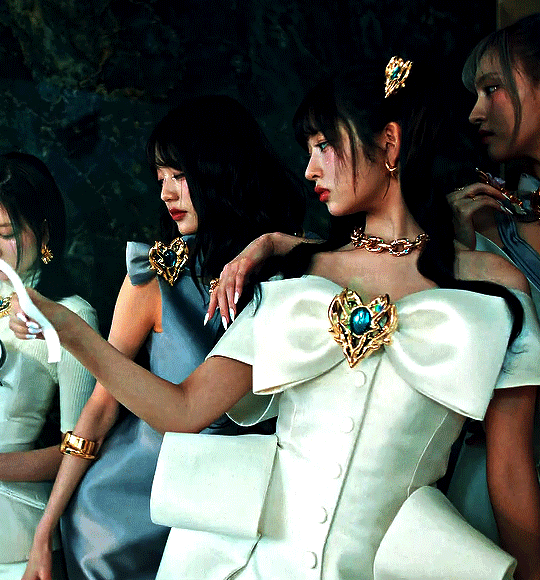
Now song by song:
해야 (HEYA)
What a fun song~! Absolutely won me first listen, definitely has that ethereal dusky wind-in-your-hair backlit euphoria to it, riding on top of a little high-heel, chin-up confidence. Powerful and pretty, in a stunning sort of way.
Yujin's part in the second verse runs rent-free on loops through my head, and the pre-chorus to chorus Ascends, I love the little transition/nod sound between them, and the way everything bursts into the chorus-- and that even that eruption of sound still outdoes itself and explodes in the final chorus, high note overlaying and all.
youtube
Visually, what a pretty mv! Exactly the sort of thing I expected from the teasers we got, and captures a sort of aesthetic that perfectly fits and conceptualizes Ive's niche. The set reminded me of that one Twice set in Scientist, but perfectly set it in a cultural and very specific nostalgic-reminiscent mood that I absolutely adore. Pastels and clouds and all. And tying it in with the lyrics? Absolutely beautiful, love!
Accendio
I won't lie, the first line set me off a little XD Why are we talking about priests, what's going on girls lol BUT THEN-- the actual ascension in the chorus outro? Those harmonies and chord building coming out? Hello there~!
Lyrically, it perfectly encapsulates the entirety of the album, and I think the chorus achieved the perfect balance in catchy and elegant that Baddie was setting them up for last comeback. I also love that I could catch this battle between evil and good in the production before the mv dropped-- the second verse drops you straight into a basement of bad intentions, and retrospectively makes that opening line confession make so much sense. It gives the pre-chorus the desparation before the chorus comes in with it's commands-- it's spells of protection almost.
And then the mv!!!
youtube
Oh what an mv. Everytime a storytelling mv graces us, I want to put it on a pedestal and run a presidential campaign for it because THISSSS WE NEED MORE OF THISSSS~~~
I love main character Gaeul, I love the girls power up moments into Sailor Moon-esque heroines, and then battling evil versions of themselves, (shoutout to the stylists, oh, keep doing what you're doing!!) I loved all the fight sequences, I loved the quirky plot of keeping this wand safe and then losing it, I love the ambience and color of the whole story-- it supported the music so well? The fast moving parts, the scenes where we could gasp as Yujin slammed her hand into the glass and beckoned us back, the throwback into the timeline, the fight sequences~
Really well done, Ive. A beautiful mash of elegant into a fun turn-of-the-season summer comeback.
Blue Heart
Heyo, Wonyoung written beauty!
The production draws straight from the lighter parts of Accendio, in that protective but smiling, fun image, in a spell, a promise of letting you come close but never as close as you want. It fits perfectly between Ice Queen and Accendio, in a heroine protecting herself, floating just above it all, but when she drops into the mess of it in the chorus, it's fully armored and confidently winning. And I do love the verses and the ascension in the bridge where it really does feel above the clouds and touched in the pastels of a free sky, and how perfectly it contrasts with the chorus.
Lyrically, I'll let her speak for her own song, because there's something really precious and admirable about the work she put into this song (end of the article):
tldr; She writes it as a tribute to female idols in a harsh industry and the image and personality they chose to put out in comparison to their inner strength to protect themselves.
I also want to include lyric analysis by @aidollze on twitter, with a special shout out to Ms Wonyoung for her legal work in bringing down a youtuber for defamation against kpop idols:

Ice Queen
Sent me right back to Hypnosis from their full album, instant love.
Musically, the production is like a bubbling, clear and fresh bubbling spring in the verses that freezes into the chorus, sharp angles and prisitine edges. It's sea-curly hair and curious smiles over the shoulder into combed back buns under a tiara, looking down their noses, critical, moving from level playing fields to a power play.
The lyrics only supported the imagery it gave me, and even added this undertone of the daughter of Halsey's Castle, especially if coupled with Blue Heart's message, which? Gives me all the brainworms? But anyway XD
Wow
How fun~ This feels like a run through a water park or summer vacation in a theme part in the chorus, and the sit-back and reminisce breathlessly in the verses and bridge.
It's funny how the lyrics talk about being opposites but attracting so well, because it gives me that rush of planets spinning frantically and almost out of control when together in the chorus, and then throwing each other out of their orbits to observe and wonder from a distance, only to be thrown back together for the thrill of it again.
Reset
"Kiki, do you love me, are you riding--"
Sorry XD A little more in the brightly colored jungle, in the weeds and unknown of things, before that lovely little astronomically intrumental production into the chorus, where you're stuck to this fun beat, childish in it's fun, almost. I don't know! This song is somewhere between the jungle rhythm and the intergalactic kids ride! And then it finishes and drops abruptly, like it's only there to quickly pass you by before you can hop on and join.
A very fun and chill ending to a bright mini album, that leaves you feeling light!
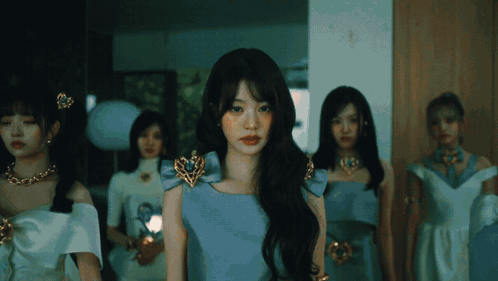
Ive always has my attention, and if the sheer vocal talent between Liz and Yujin isn't enough, their commitment to their niche of elegance while being able to try and sort invent concepts, has me tuning in each and every time.
Would love to hear thoughts people had on this comeback or on Ive in general!!
7 notes
·
View notes
Text
Glee Musical Retrospective: Hell-O Extras
Don't Rain on My Parade (Instrumental)
youtube
I couldn't find the actual scene - but I found this really fun karaoke version in case you guys wanna play at home ;)
Anyway... this song plays in the background of the opening scene when Rachel, Mercedes, and Kurt are all walking in the hallway. It's the only song that isn't related to the word 'hell' and is really a nod to the previous group of episodes, their sectionals win, and the fact that Rachel believes she's now a star -- her own triumphant music playing in her head. Of course that all comes crashing down as they get slushied, but it's a nice opening touch.
It's also quite the energetic and provocative piece even without the vocals and gives the reentrance of the show some oomph. I recommend taking a moment and just singing it for yourself! ;)
Hello, Again
youtube
Will and Emma dance to Neil Diamond's Hello, Again. I find it kind of interesting that they didn't let Will sing this to her -- and for that matter, Will (and Emma) don't have any songs to sing together this episode -- which shows the departure of the story from the adult world.
I think this is a really nice song for them, though. The lyrics reflect a man who's happy to be in the arms of his love and friend -- and the scene kind of does the meta'ing for you, actually. It's gentle and calm and kind of reflects the friends-turned-lovers relationship that Will and Emma have taken. Plus, the dancing together is somewhat reminiscent of those old school romantic films.
What I don't totally buy is that it's Will and Terri's prom song. Not only do I not buy that teens in the mid-90s would be into Neil Diamond, but I'd bet Terri would be much more vocal and dominating about that kinda thing. But it does very much reflect Will and his personality, so who knows.
I do think it reflects that the writers often write Will as being much older than he actually is -- since a lot of their choices often reflect someone who grew up in the late 80s. But I digress...
<>
Hello Twelve, Hello Thirteen, Hello Love
youtube
Oh my gosh, this scene.... lol
I can see why they cut it. I mean, it was probably for time more than anything, but I feel like this whole sequence really highlights how Rachel and Jesse 'get' each other. It might also be a lot -- too much too fast, especially when Finchel was a tirelessly slow burn over the previous 13 episodes -- so it's a bit head spinning.
But I do like the scene overall. The song is about growing up -- and discovering your sexuality -- though in the most theater kid way (which makes it kind of funny, tbh). And it's interesting to me -- that while Finn was the subject of Rachel's idolatry, Jesse is a very realized romantic partner for her. And I wonder if one reason they cut it is that it undermines the overall Finchel story when Rachel and Jesse click in a way that Rachel and Finn never have.
(I also wonder if this scene is too similar -- though in a more childish way - to the upcoming Like A Virgin montage that will be coming in the next episode - another reason they probably cut it.)
Anyway, the song is cute, but is a minor inlay of the major fabric of the St. Berry romance.
7 notes
·
View notes
Text
My Thoughts on the New MHA Opening and Ending

I have thoughts, and I will share them because oh boy if I don’t get this out I’m gonna explode
Vague Spoilers for the manga (up to chapter 258 and vigilantes) because I discuss the upcoming arcs, but I don’t discuss any major plot points in detail. Still, proceed with caution if you’re anime only
Keep in mind, this OP and ED will cover the Endeavour Agency Arc and the MVA Arc, so I will be judging them accordingly.
First, the OP
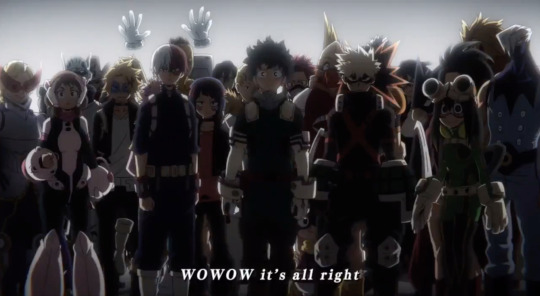
This is a good OP... in theory (that’s going to become my catchphrase for this post). It’s nice to look at and flows pretty well, but my biggest problem is that it doesn’t do it’s job. An OP is supposed to be a sort of... summary (?) of the Cour it plays for. That means any cool plot points, emotional beats, and important characters should be featured in some way, shape, or form. We’ll talk about that more later, but first let’s discuss the music.
The song is really good. I have a feeling it will continue to grow on me as I listen to it more often, but yeah my first impression is that the song sounds great. My only complaint about the music itself is that it ends kind of abruptly (I noticed this is the JT opening too). The previous openings used to have a bit of instrumental to “play us out” and lead us to the end card, but this one feels like it ends very suddenly and unnaturally.
As for the visuals...

Yeah alright I’ll admit, the visuals are stunning... in theory. I appreciate the variety in backgrounds and colours, it makes the OP really interesting to look at. This was actually one of my biggest problems with the JT Opening, it all took place on the training grounds, so there was no variety (everything was metal tubes with a blue sky, with only 3 shots set somewhere different). I appreciate the style of this OP.
But like I said, that’s only in theory, as in, through screenshots these are all pleasing to look at. The pacing of this OP is wild, and I truly don’t know who to blame for this.
That sunset shot above? It lasts approximately 12 seconds, zooming in every few to make it seem like something is happening (when in reality it’s still the same poses, angles, etc). While there’s nothing wrong with a nice, drawn out shot, it becomes irritating when compared to the pacing of the rest of this op.
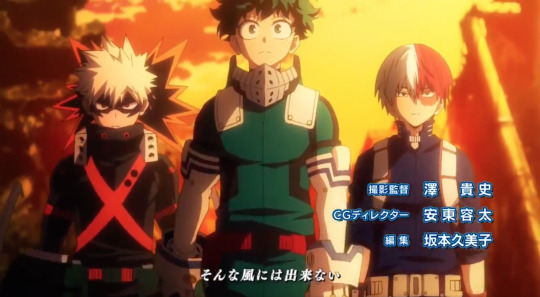
At the 41 second mark, we are given the shot above. It has flowed directly from the previous sunset scene. We still have not moved away from the image of the trio (aside from the opening shot and the title card) yet we’re approaching the halfway mark of the OP.

The next shot is the MLA, which lasts about 5 seconds. Ok, perfect. Not too long, but also not short enough to be confusing. It cuts away a little fast once the dude on the far left appears, but does anyone actually know who that is? No, seriously, I’m asking. I don’t remember his name and he’s not on the wiki, so I can only assume he’s not important. Therefore, it’s not all that bad if the shot cuts away shortly after he comes into frame. The audience is able to take in the scene without having to pause...

... And then the problems start
While this shot is fine in theory, it pans up fast and cuts away quickly. You know how hard it was for me to get this screenshot? Really hard. You want to know why I struggled so much? Because, due to the timing of the cut and the way it pans upwards, it’s almost impossible to pause on Dabi’s face. I literally had to go frame by frame to get it, because he’s in shot for so little time that naturally pausing is guaranteed to miss him.
When watching this in real time (without pausing) the cut away makes you feel as if you missed something because “something was there, I just couldn’t register what because now it’s gone”. Unlike Compress, who wears a very colourful coat you can recognize the entire time, Dabi’s pants are more blended into the background.
It also doesn’t help that this shot is literally composed to draw your attention away from Dabi until the last possible second. Due to framing, your eye is naturally drawn to the brightly coloured Toga in the foreground, making it super easy to miss Dabi in the back (until, of course, his bright face appears and contrasts against the background, drawing your eye just in time for the scene to change, leaving you to wonder who or what you missed).
I know this sounds like nitpicking, but this shot is the only group shot we get of the League, and is also the start of a seriously weird trend for the villains in this OP getting the short end of the stick.

Anyways, then we get what I’ll call “The Carousel Shot” in which every Class 1A kid shows up and poses dramatically, as if they were on a carousel. It’s a lovely sequence and I really enjoy watching it but... why is it in this OP?
Seriously, this is a genuine question. Class 1A barely shows up in the Endeavour Agency Arc, and NONE of the students are in MVA. This sequence (not counting the three boys at the end) lasts 8 seconds. Why is this much time dedicated to characters who are barely in the arc? (Unless Studio Bones extends their work studies into fuller plot lines which oh my gosh please don’t do that, or if they do, do it quick).

We then get what I call the “Oh God I Blinked And Missed Everything” sequence, which lasts 3 seconds (not including the longer, moving shot of Shigaraki at the end) and features NINE INDIVIDUAL IMAGES, none of which are related to each other. Not only is this 3 images per second, but the fact that they are all unrelated means you can’t even use previous information to fill in the blanks.
What do I mean by that? Well, imagine if I show you 9 images of various pro heroes posing. If I play that in 3 seconds you’ll absolutely miss some of them, but as long as you catch some you’ll still get an idea of what I’m trying to show to you. Your brain is able to fill in the gaps that “I recognized 4 pro heroes, therefore the rest must have also been pros” even if you didn’t register every single frame.
That doesn’t work if every frame features a completely different subject. The shots in this sequence vary so widely that it’s impossible to find a through line. Some feature multiple characters, some feature one, some are closeups, some are super far away, some are character’s we know, others are characters we don’t. It’s impossible to get a solid read on what you’re being shown.
Now, again, there’s nothing wrong with these super quick shots... in theory. The problem comes from the fact that these shots are the only indicators for some of the major themes that will be explored during this Cour (like Twice’s growth and young Shigaraki).
That being said, let’s move away from criticism and talk about speculation, because hidden amongst this sequence are two... interesting images.
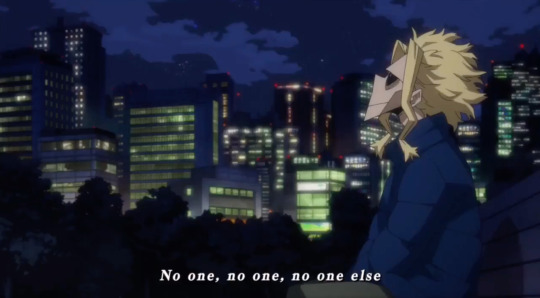
This All Might one is very reminiscent of the shot in Chapter 257, where Aizawa and All Might have a conversation while staring up at the stars. However, this is technically the start of the “War Arc” (or the “prologue”, if that’s what you want to call it), so this might indicate that we’re going to get farther into the series than a lot of us guessed.
(Many people suspected we’d get to that cliffhanger at the start of the season (if you read the manga you know the one), but after seeing the pacing for JT a lot of us assumed we’d be lucky to even finish Endeavour Agency. It seems we’re back to the cliffhanger now though lol).
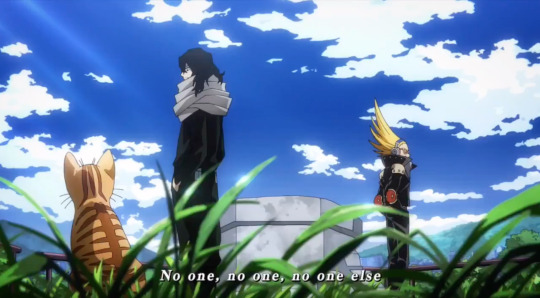
This is another really interesting shot because it’s indicative of Shirakumo, meaning we might get to see Aizawa and Mic confront him some time this Cour (this also makes sense, since this confrontation technically happens before that All Might scene I mentioned in the previous paragraph).
But the cat specifically is a really strange addition. That cat is named Sushi and, correct me if I’m wrong, but I don’t think Sushi is ever mentioned in the main series. I think he’s only in Vigilantes.
This might just be a little Easter Egg for Vigilante readers, but I’m personally hoping that they’ll add at least a few Vigilante shots in there to really tug at the heart strings. I’d say I want a whole Vigilante episode but I don’t think they have the time (unless they really cram MVA, which I do NOT want).
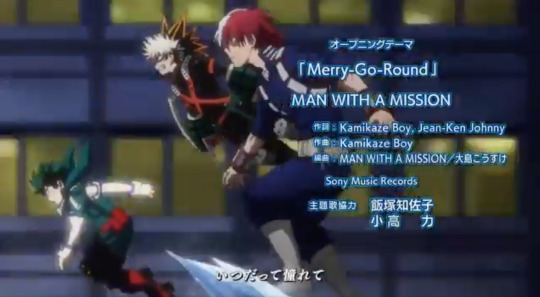
I don’t have much to say about the last bit of the OP. The action shot between the 3 boys was nice, and it follows the sort of narrative through line they established from the early shot of them sitting at the sunset. I also like the shot of Endeavour fading in to replace All Might, even if it’s very simple.

But I want to talk about an overarching problem I touched upon earlier in that villain shot: the way the villains are handled in this OP.
This is a good OP... in theory. The problem is, it doesn’t represent half the arcs in the cour! Every shot of the League is so rushed that you can barely register that they were on screen before they’re gone.
I have no idea how many Episodes Endeavour Agency will take, but I’d assume 3 (4 if you count the Christmas episode). 12 episodes for this Cour minus 3 for Endeavour Agency = 9 episodes left. If we truly do get the prologue for the War Arc (and if we assume it’s only 1 episode) that leaves us with 8 villains episodes.
8/12 episodes (aka two thirds of the Cour) will likely be about the villains. And yet they’re pushed to the background so hard in this OP.
I want to dream, and I want to believe that this OP is going to magically change when MVA starts. The song fits super well, and I can imagine like an inversion of the OP but from the Villain side! Wouldn’t that be neat? Imagine right after the “it’s alright” part Shigaraki just freaking decays the title card... oh man that would be so cool. But, alas, I highly doubt they’d do that.
Side rant, but you know what was so fun about MVA in the manga? It’s that, for 21 chapters, we leave the kids behind and the villains become our protagonists. Suddenly Shigaraki is the one we’re rooting for, suddenly we’re learning backstories for everyone, and suddenly we find ourselves just as attached to the villains as we are to the kids. It’s an inversion that’s SO RARE to find, and I think many people (myself included) were hoping it would be reflected in the OP.
A big part of being the protagonist means featuring heavily in the OP, and a lot of us just wanted the villains to get that honour, even if only once. As is, the OP still treats them as the antagonists when... really they aren’t. Not right now, at least.

So yeah, final thoughts on the OP are that it’s good, it’s just not very representative of the arcs it’s supposed to cover. If this was just for Endeavour Agency, I’d say it’s actually really cool, but if we assume that this is what will play for the Villain Arc, then it simply doesn’t do it’s job. And it makes me sad to say that because, again, this OP is really well done.
If I had to rate it? Hmmm
If Studio Bones actually grants my wish and creates a different visual for the Villain Arc (while using the same song) and then this version only plays for the Endeavour Agency Arc and the War Prologue? I’d give it an 8/10. It’s really good, but it could use a few more elements that are clearly derived from the Agency Arc (ahem, Todoroki siblings).
But if this is the OP that will play for the entire Cour? a 6.5/10. It’s nice, but it’s not representative of one of the arcs it’s going to cover. And, unlike other arcs like Pro Hero or Summer Exams, the villain Arc is so important and takes up so much time that it honestly feels like a bit of a disservice.
Now for the Ending
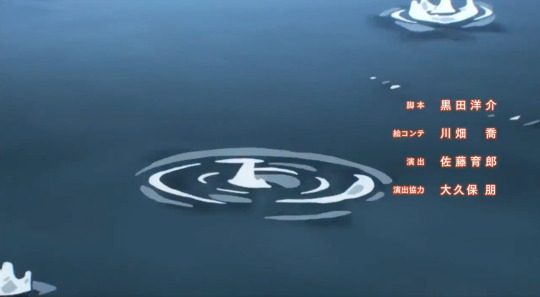
I want to say that I appreciate how soft this ending starts. This cour will likely feature a lot of episodes that end on... heavier themes, and I think the sight of peaceful, falling raindrops is the perfect way to let the audience process their emotions before starting the ending in earnest.
The song itself is very nice, and I like that it’s a bit slower than the more recent endings.
(Side note, but the FUNNIEST moment in the entire series is when Sir Nighteye dies because it’s so emotional and everyone is standing around his bed in his heartwrentching silence, only for the ending to come BLARING IN out of no where. If you forgot how jarringly hilarious it was, go listen to the Eri ending and tell me that’s not the funniest thing this series ever did. Anyways yeah I’m glad that’s not gonna happen this Cour).

This ending is a bit all over the place in terms of it’s visuals, but honestly I think it works. Most endings usually have a theme tying them together (all the Class 1A girls, a fantasy AU, old photographs, planning a party, etc) but this ending’s theme is a bit harder to identify.
That being said, I think it’s just supposed to show everyone going about their day. It’s calm, it’s peaceful, and it’s just very sweet to think about

I like this shot. Actually, scratch that, I like this whole sequence. I enjoy anything that allows Class 1A to chill and have fun.
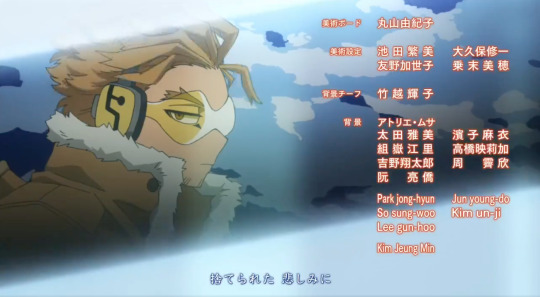
Hawks is featured quite heavily in this ending which, fair. He’s pretty important in this arc.
I really love the shot where Endeavour immediately switches to Hawks, I thought that was a lot of fun, and very good symbolism on how Hawks wants to be like Endeavour. I also love all the shots of Baby Hawks, because it’s adorable.

Something about this shot is just so cute. It’s the little domestic things like waiting for a bus that make this ending feel... idk the word, real? It shows a side of the characters that we’ll never see in the episodes, but we know have to exist.
Like yes, of course the kids have to wait for the bus. We never see it, but of course there are those moments of quiet. Agh, I love it.

The villains also make an appearance and I’m very happy about that (I’d love to see more of the villains just chilling around, I think they deserve it). I kind of wish they weren’t sitting in a dark room for the sake of being edgy, since I think it would be nice to see the villains just... sort of existing, but honestly it’s still a nice shot. I also like how this shot sort of mirrors the first one with Class 1A (someone coming in while everyone else is sitting and waiting for them).
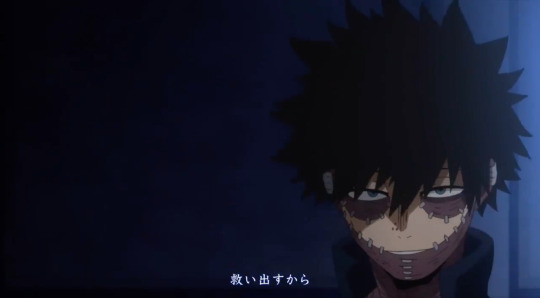
That being said, as much as I love looking at Dabi and his stupid face (affectionate)... why is Dabi the one getting the closeup?
Mind you, endings don’t need to be connected to their Cours (they can be, like the Eri one, but they don’t have to be). But this ending does seem to be connected to the arcs it intends to cover, given all the Hawks appearances, the boys wearing their work study scarves, etc.
So, I ask again, why Dabi? Out of the six League members, we learn the backstory for four of them in this arc (Shigaraki, Toga, Twice, and we very briefly learn about Spinner). The only two left out are Dabi and Compress.
I can only assume they chose Dabi because he’s constantly in contact with Hawks, and therefore that makes him important? If the OP told us anything, it’s that Bones values the Endeavour Agency Arc over the Villain Arc lol...
... Oh my gosh please tell me that’s not actually the reason Dabi is focused on here BONES WAI-

Anyways, the ending comes to a close with Hawks watching over the kids and Endeavour. The relaxing time is done, it’s time for work studies.
Overall impression? It’s great. It’s hard to screw up an ending, so as long as you have something pretty on screen, it’s wonderful.
I’ll give this a 9/10
#bnha#bnha season 5#dabi#keigo takami#bnha season five#katsuki bakugo#shoto todoroki#mha season 5#mha season five#bnha op#bnha opinions#izuku midoriya#bnha hawks#ok to reblog#actually yes please do reblog if you found this interesting#I worked hard on it
30 notes
·
View notes
Text
An analysis of Higurashi Sotsu’s new OP, “Analogy” by Ayane
Spoilers for Higruashi Gou and speculation about Sotsu under the cut
Higurashi no Naku Koro Ni Sotsu
A duel between loopers.
Two gods intertwined and yet diametrically opposed.
Feelings unspoken, and voices unheard.
Another perspective on the events we had previously seen.
The difficulty of this chapter is medium.
Let us conjecture on where the pieces shall fall.
Pardon me the opening, my experience through the original series was through the visual novels, so I had to. As the title says, this is an analysis of the new OP. Enjoy.
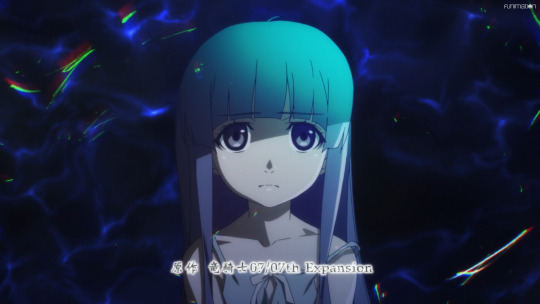
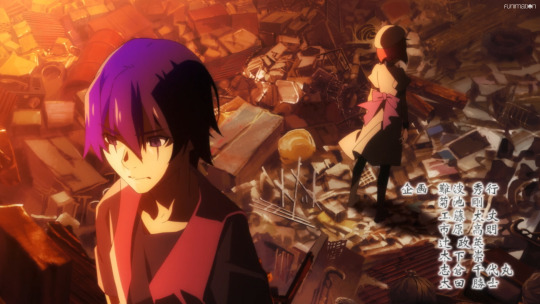
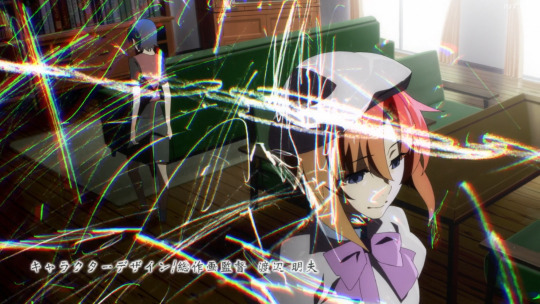
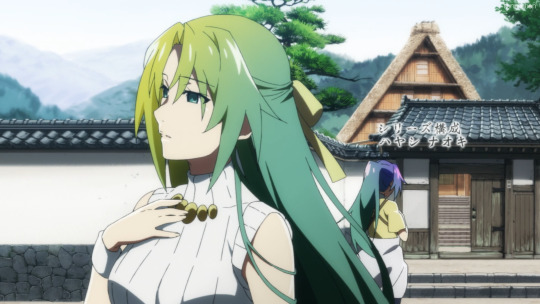
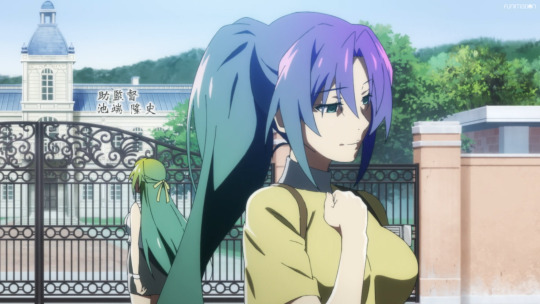
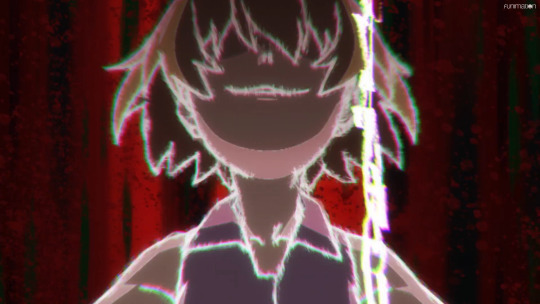
To start, we see Rika in an abyss of darkness, with a downtrodden face, and end our little opening sequence before the music picks up and the distortion on Ayane's voice is lost with Satoko falling backwards into a scenery very reminiscent of imagery used in the very end of the "Irregular Entropy" ending. This could be the starting of a theme we see a lot in which we see that Rika's approach at the loops is very passive, while Satoko with her modified powers takes a much more active roll in achieving her goal.
In between these we see images of Keiichi, Rena, Shion, and Mion in pairs in front of backgrounds that depict their inner struggles, but of the one who is not in focus. For our first pair, we have the junkyard and Keiichi's house, alluding to their issues relating to their family, Rena's being a very rough divorce and Keiichi's being high standards placed on him that eventually broke him. Shion and Mion have something similar, with the Sonozaki main house and St Lucia, alluding to the burden that Mion carries as the heiress to the Sonozaki household and the neglect that Shion suffered. These also carry double duty in giving some visual ties to Onidamashi and Watadamashi that we will be seeing the answers arcs to soon.
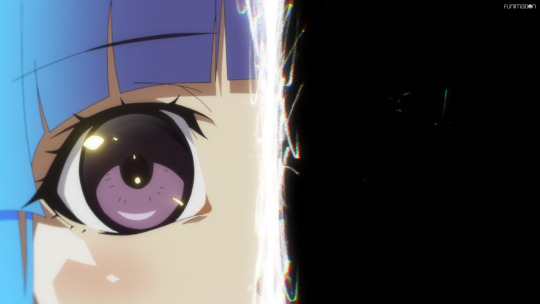
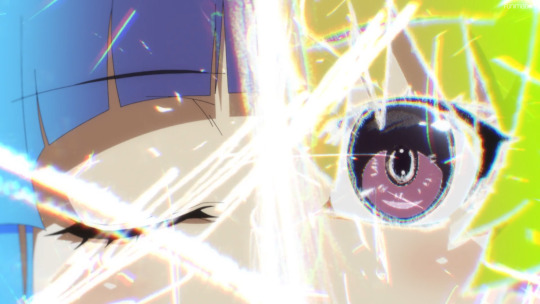
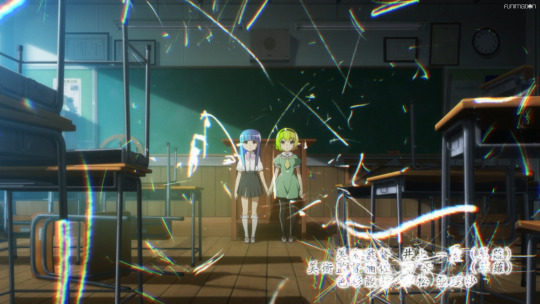
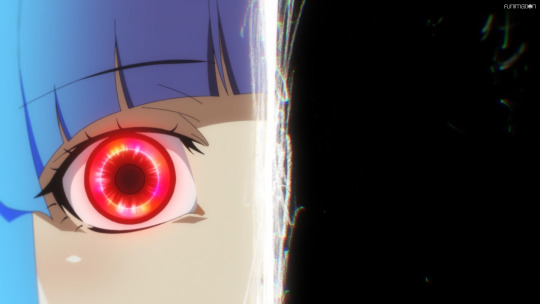
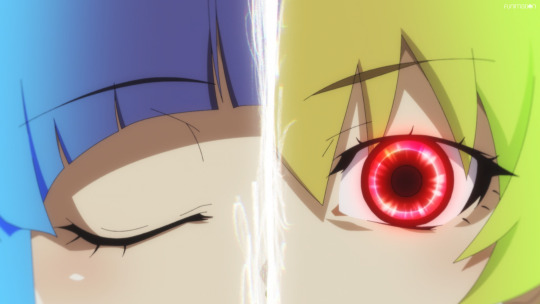
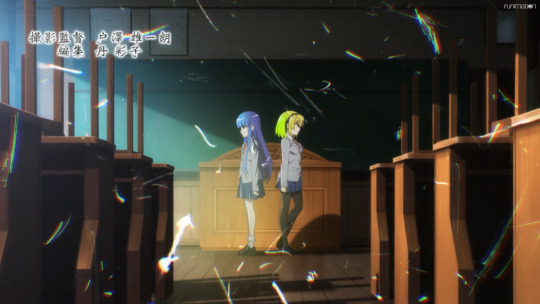
Next up we get our girls Rika and Satoko. Rika closes her right eye, and across the split screen Satoko opens her left. We then see them together at the school in Hinamizawa, facing the same way with their hands together. The chairs are in disarray, some set up on the desks, some not, and one is even laying on the floor. Things were chaotic for them, but no matter what they had each other. And then, things changed. We move into the eyes closing and opening again, only this time they have that look that denotes them as loopers. The classroom this time is now what appears to be their classroom at St. Lucia, with everything very orderly, but this time the two are facing away from each other. Of course, this shows their growing distance on their way to high school.
However, we move into the next line of the song.
“I want to be with you”
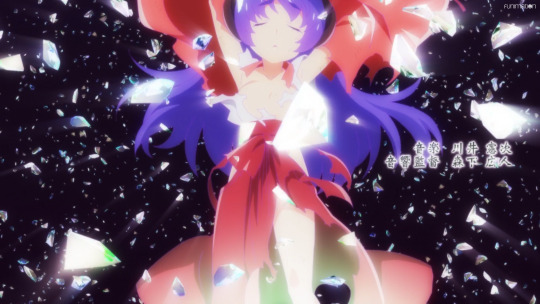
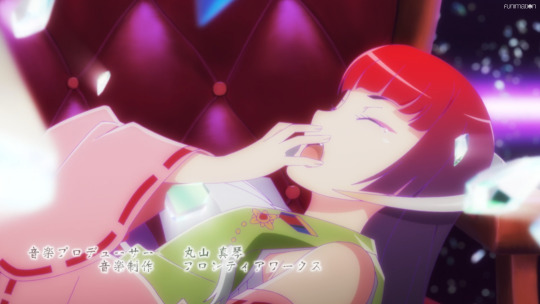
We than move into a shot in the Sea of Shards where Hanyuu is... well she looks like a Fire Emblem Heroes character below half health. And when we see Eua, she’s draped on her couch, seemingly bored. I speculate that this is solidifying the connections between the two that we already have that I will go into later, as well as that Eua is some sort of usurper of some kind. Perhaps she’s holding Hanyuu hostage, stealing her powers, who knows. I know there’s speculation between Eua, Hanyuu, and Featherine, but not only do I not have the knowledge of Umineko to speculate on that, but that’s a whole essay on it’s own.

Next, we cut to this shot, zooming out to show the entire forms of Rika and Satoko as they move in to each other. Mind you, I am a VERY strong SatoRika shipper so I do have some bias (that edit where the two are kissing in the closer shot is the best), but it is very clearly that these two long for each other. Their growing distance at St. Lucia has left them yearning to be together again, and perhaps more. Most likely more. Ryukishi make it happen.

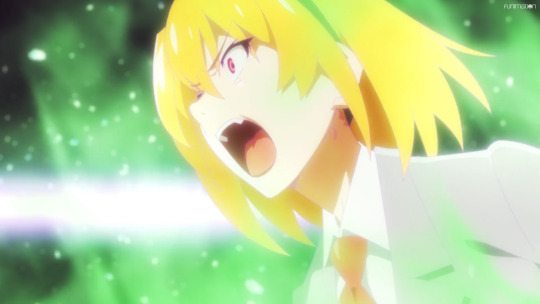
Than like all lesbians they have a Sayan battle within the Sea of Shards. Honestly, this seems to just be regarding the conflict between the two.
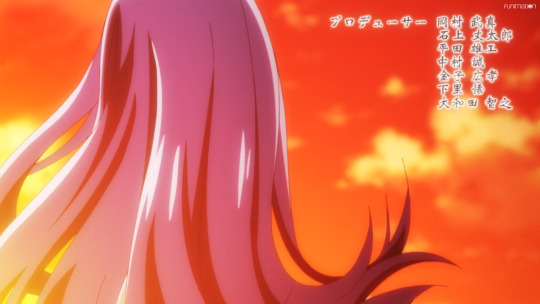

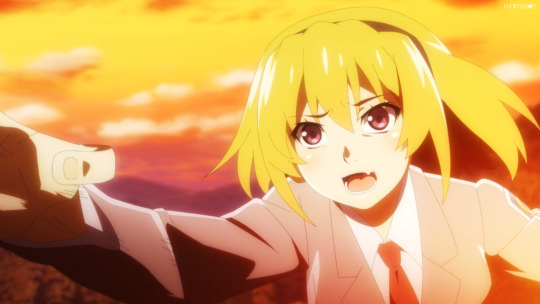
We then see Satoko running along the rice paddies at sunset, reaching out to Rika. This parallels a scene from “I Believe What You Said” in which Rika is running through the forest at night, reaching out to the saiguden and likely Hanyuu
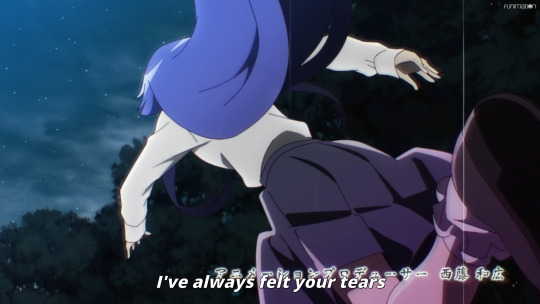
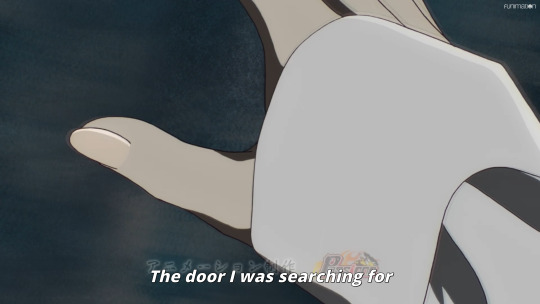
This parallel here is likely to show how the two are similar in goals even if they don’t realize it, as well as conceptualizing time and that Satoko chasing after Rika here is before she got her powers.
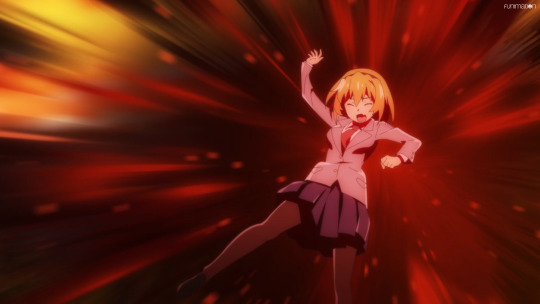

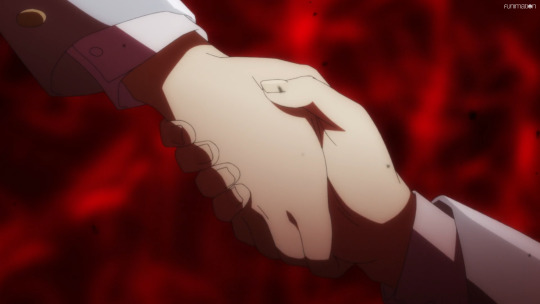
We then see Satoko fall into a red abyss, nearly fade away into dust, but has her hand grabbed onto by what is assumedly Rika by the blazer and cuff being that of St. Lucia’s uniform. Despite everything, these two anchor each other. At the end of this whole thing, they likely will find each other again and make their way through all this trouble and chaos. I even speculate that Satoko falling into the abyss here is foreshadowing that Satoko is falling into depravity here, that Eua has corrupted her mind and actions, and that finally putting her plan into motion, especially during Tataridamashi, has led her to want to escape. The speedrun of suffering in Nekodamashi was I think Satoko breaking and wanting to get her ‘win’ in as soon as possible and return everything to a perfect world so she could cast these powers, cast this suffering, aside while also not loosing her stubbornness.
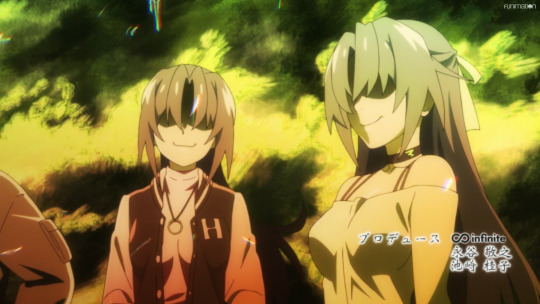
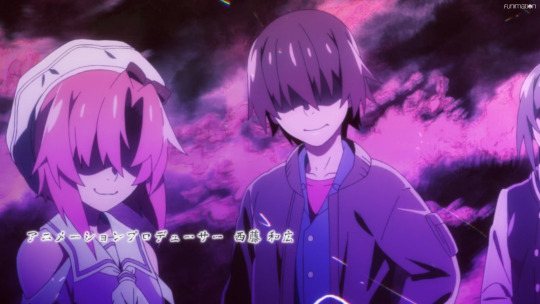
This here is.. confusing. It’s nice to see more of our gang aged up, but these faces are a bit off here. Perhaps it’s perceptions of Satoko’s regarding her friends having left her to go to high school college? Who knows.
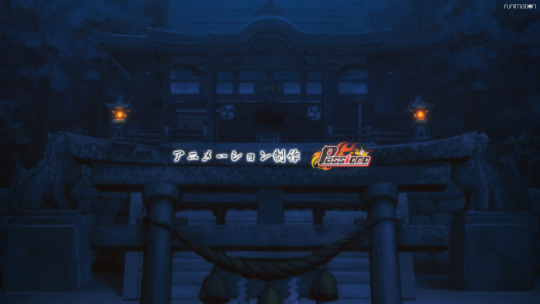
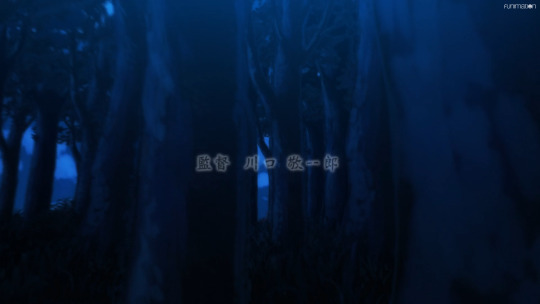
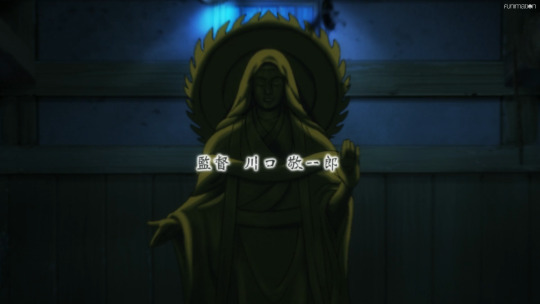

As we near the end, we see an upwards shot of the Furude shrine, a shot through the same forest that we see Rika running through in “I Believe What You Said”, a shot of the statue of Oyashiro-sama, and than Eua in the sea of shards. To me this just feels like more tying things between our two new OPs together and further solidifying the ties between Eua and Hanyuu, whatever those may be.

Finally, we see a shot of Rika and Satoko, young, looking over Hinamizawa, holding hands at sunrise. Once again, these two care deeply for each other and will come out the other side together and stronger than ever. Again with how time has played in this OP, we go from late day at the beginning, to sunset, to night time, and now everything has cleared. The demons hide away until their next coming, but these two will be there for each other whatever may come.
And thus concludes my analysis. Please, do leave any comments or feedback, and I look forward to seeing how things play out in the show this season. I hope you are as well.
#Higurashi#higurashi when they cry#when they cry#satoko houjou#rika furude#higurashi sotsu#spoilers#higurashi spoilers
26 notes
·
View notes
Text
Tales of the Unexpected: SANTA CLAUS

Most of my life I’d been haunted by an image—five seconds from a film I could not name: Santa, in someone’s living room on Christmas Eve, fires a toy cannon at a demon’s ass. That’s all, but it stuck with me for decades. The only thing I was sure about was that it came from a film my father had taken me to see when I was four or five. There was snow in the theater parking lot.
It clearly wasn’t a typical holiday film, so as the years progressed I decided it must have been Santa Claus Conquers the Martians (co-starring Jamie Farr and Pia Zadora as martians), but I was mistaken. There are no demons in that movie. I asked my dad, but he had no idea what the hell I was talking about. Then, as the universe would have it, when I was well into middle age the film was placed in my hands by someone who had no idea I’d spent much of my life looking for it. Seeing the film in its entirety for the first time in 40 years, I finally understood why things might have turned out the way they did.
When the conversation rolls around to bad Christmas movies, there’s of course a broad spectrum from which to choose. Given that nearly every Christmas movie ever made is insufferable to some degree, it’s generally easier, I’ve found, to break things down into categories that stretch from the simply godawful (Jingle All the Way) to the agonizingly painful (A Very Brady Christmas or that Marlo Thomas remake of It’s a Wonderful Life) to the merely baffling (An Ewoks Christmas). Of course there are some people who think they can bring the conversation to an abrupt end by pulling out Santa Claus Conquers the Martians as the last word on holiday cinema. There’s simply nothing more to say.
Oh, but that’s far too simple. There’s another level out there. Something that reaches far beyond banal categorizations like “good” and “bad” and even “weird,” deep into the almost unfathomable territory of “brain damaging” and “utterly terrifying,” and a number of adjectives that have yet to be discovered. Films that cannot and should not be called “bad” no matter how easy it would make thinking for the smug hipsters in the Mystery Science Theater crowd. These are films that come from another plane, another universe, another way of thinking, and for that they remain fascinating, and cannot be so easily dismissed.
In the 1950s and ‘60s, K. Gordon Murray was an American film producer and distributor who made a decent living for himself by picking up the rights to foreign genre pictures (mostly from Mexico), dubbing them into English, and renting them to U.S. theaters. English-speaking audiences can thank Murray for The Brainiac and Robot vs.The Aztec Mummy.
In 1956 he bought the rights to a children’s holiday picture directed by René Cardona, a man better known for horror and exploitation pictures like Survive! and Night of the Bloody Apes. Instead of widespread distribution, Murray limited the film to short (two or three day) runs around the holidays, when the film would only be shown as a children’s matinee. In retrospect I have to wonder if he limited viewings that way because he knew what kind of effect the film would have on people.
Santa Claus sounds about as innocuous as they come. Who would even pay attention to a title like that? It’s only when you note the shrill, almost frantic tone of some of the taglines attached to the film that you begin to get some sense that there’s something else going on here—that this isn’t another Rankin/Bass production:
Bursting upon our BIG SCREEN in all the colors of the rainbow… a prize-winning blue ribbon treat for old and young alike! Here’s something for the whole family to see together!
Another tagline makes it sound even more ominous:
See All the Weird and Wonderful Characters of Make-Believe! The Fantastic Crystal Work-Room of the Happy Elves! The Fabulous Realm of the Candy-Stick Palaces!
Those families who weren’t scared away by those dire warnings were never the same again.

René Cardona
In Cardona’s vision, Santa (José Elías Moreno) lives in a cloud kingdom in space, positioned in a stationary orbit above the North Pole. Instead of elves, Santa has collected groups of children from all corners of the world—North and South America, Europe, Asia, Africa. It’s unclear who these children belong to or if they’re in space willingly, but they open the film with a long recital of traditional songs from each nation.
Ten minutes later we cut to Hell. Although this happens in most Christmas movies, few do it so literally. There amid the flames, Satan informs a minor and bumbling demon named Pitch (José Luis Aguirre ‘Trotsky’) that he is to turn all of the children on Earth evil in order to anger “that old goat Santa Claus” and show the people of the world “who their true master is.”
We are then introduced to three storylines: a lonely rich boy whose parents neglect him, a poor girl whose single mother can barely support them both, and three young thugs. Behind each story, we hear Santa’s echoed laughter. Santa laughs through the entire film, often at scenes of misery and despair. It’s unclear why.
Finally and centrally, we see the core of Santa’s orbiting kingdom—an observatory equipped with a collection of surveillance devices that would put the NSA to shame. As the narrator (Murray himself) describes it:
This is Santa’s Magic Observatory. What wonderful instruments! The Ear Scope! The Teletalker, that knows everything! The Cosmic Telescope! The Master Eye! Nothing that happens on Earth is unknown to Santa Claus!
He’s not kidding, either. Santa can see anyone he chooses merely by thinking of them, listen to what they’re saying, even watch their dreams, and these are powers he abuses freely.
There is no reason to attempt to describe the plot any further. It’s not an issue. Visually, however, the film is a thing of deranged wonder, reminiscent of Japanese films that would be made ten or fifteen years later. It’s a world of remarkable and sometimes frightening imagination. The telescope features a large, roving eyeball instead of a lens. Santa’s sleigh is actually a giant wind-up toy, the living reindeer replaced with carousel reindeer made of white plastic. The color palate throughout the film (if you can find a decent print) is intense. And the film’s multiple dream sequences are, well, pretty jaw-dropping.
It’s also a remarkably subversive film—which intertwined both with the visuals as well as the director’s background, may be no surprise at all. Along with the kidnapped children he’s using as slave labor, the cannon he fires at the demon’s ass, and Santa’s often inappropriate laughter, which snakes throughout much of the soundtrack, there’s Merlin, another of Santa’s employees. Merlin runs a drug lab, and on Christmas Eve has just developed a “magic powder” that will “give people a sound sleep and fill them with wonderful thoughts and good intentions.”
Santa is perfectly willing to deliver babies to children who request little brothers or sisters, and one good little boy is set to receive “an atomic lab and a machine gun.” And then of course there’s the role of the demons here, in a world in which Santa and his toys have replaced Christianity.
It’s a film that’s often mocked by fools for its cheap sets and bad acting, without pausing to think about what’s really going on here—the kind of twisted, alien imagination at work, or the ideas that Cardona is sneaking in under their smug noses. It’s a deeply strange and disturbing work, a visionary work on a minuscule budget, and one that says more about the holidays than we may care to think about.
Maybe that’s why my dad has blocked it out of his memory, and why I spent a lifetime trying to track it down.
by Jim Knipfel
3 notes
·
View notes
Text
Hyunjin "Play With Fire (Feat. Yacht Money)" (원곡 : Sam Tinnesz) | [Stray Kids : SKZ-PLAYER] ~A Love Letter~
I talk about why I love this video so much and deliver an excruciatingly detailed play by play of it, but why read a two thousand word, five page essay on a three minute video when you can just go watch the aforementioned three minute video? Forget me spending hours writing this, why are you here, seriously, it would take you significantly less time to watch the actual video. Regardless, enjoy my attempt to refrain from saying the same three things, “he's so cool”, “I love him”, and “this is so good”, in exchange for a more, hopefully, academically professional sound.
Watching him perform never fails to put me in a trance, it’s incredibly captivating how precise and sharp while simultaneously lively and energy-filled his movements are. This video feels reminiscent of enjoying a movie I’ve seen countless times, memorized every line of dialogue from, and genuinely think of every part as the best it has to offer. I greatly missed seeing him dance and having this as his grand welcome back into the spotlight is nothing less of a gift. Every second leaves my heart pounding and as excited as the last, as he continuously tops himself the longer I watch. I feel that revisiting the video is the least I can do, for giving it only one view doesn’t feel morally acceptable if I intend to truly appreciate it for that art that it is. Dramatic of me? Perhaps, but I can’t help but perceive it as more than just this one video that was uploaded onto their YouTube channel. It isn’t just about all of the work he and others put into the making of this particular video, his choreography for the song was a result of years upon years of practice and learning different techniques. A performance this good doesn’t only involve technical skill though, but also skill in regards to one’s inner mind. To have confidence in one’s self, to hit every move powerfully, to know what you’re doing and be unapologetic about it, that is skill. Sure, the performer is at the focus of any performance, but don’t forget that it’s also about the audience, it is after all for the enjoyment of the viewer. If the audience senses your doubt and insecurity and uncertainty, it will make your stage that much less enjoyable. Whatever you feel, they can feel too. When I watch him, I don’t feel any of that. In fact, I feel the exact opposite, I feel inspired, motivated, confident, excited to advance in my own endeavors. The emotion that this video evokes from me goes beyond anything Stray Kids or K-Pop or even dance itself, it makes me want to be a better person, be kinder to myself and work harder. That might sound like a lot for one video to do for someone, but it’s the truth. All of the details, even down to the individual frames, it all works together to create the most gratifying viewing experience. At the time of writing this, the video has just hit five million views and has over one million likes, only a mere three days after its initial upload.
The first shot of his footsteps alone, as he goes to stand in front of the mirror, I already feel this sense of importance coming from him, delicate, yet powerful. The setting, cold and empty, yet inviting, it makes room for him and gives him just enough light to be seen, for he doesn’t need all that much help to surely shine. The credits that pop up use a dark shade of pink-red for it’s background color and white text that acknowledges the same deep red imagery and text associated with the material of the original work. His outfit is neat and pristine with some sparkle, resembling one a prince would seem fit. He stares at his reflection, holding a sheer white ribbon in his mouth, gathers a section of hair behind his head and proceeds to tie it with said ribbon. The music starts as he finishes tying and lets his arms fall down at his sides. The over the shoulder shot looking into the mirror, shows that his expression is neutral, almost calm. This can most certainly be described as “the calm before the storm”, except the storm itself is antonymous to a tragedy, because when the singing starts, it’s as if his performance persona was turned on by a switch, a charismatic possession that took place in a matter of seconds that sends chills down your spine in the best way. His previously neutral, calm-like expression and gently resting arms are quickly replaced by the sudden placement of his right hand around his neck and a look that resembles more of a vengeful, hesitant, and somehow playful one. Similar to what I’d imagine a villain would look like right before being bested during an epic fight sequence at the climax of a film. It’s satisfying to see him popping to the beat’s rhythm, his arms, wrists, and head smoothly illustrating the flow of the words, his focus and the secure angles he’s able to form before even fully utilizing his lower body. On the line “Got secrets I can’t tell”, he delicately places his pointer finger in between his teeth, as he turns back to meet the camera with his eyes, the shot now semi-closely focusing on both Hyunjin and his reflection as opposed to just one or the other. He extends his right arm, his hand forming a fist, and the camera movement making it as if I’ve been punched and sent flying. He stumbles to the middle of the room, does an opening gesture with his arms, like a proud baker showing off their completed wedding cake, along with a dramatic spin incorporating his thin, white, flowy cape. Reaching the pre-chorus, we get to see the room more clearly, like the stone pillars and the contrast of the small, warm lights on the walls to the grand grayness radiating from the large window that makes him appear as a near silhouette. There’s a certain holiness about him spending a count with his head down and arms out, much like the Crucifixion of Christ, before showcasing more of a demonic energy when he faces the window with his body, but bends backward and looks to the camera upside down. He rips off the cape, tosses it behind him, to his right. This could symbolize a transformation, an abandonment of a particularly purer image of oneself, a liberation. The music picks up, and the manner in which he dances is like a visual representation of one’s inner turmoil combined with an agenda to seduce those watching, wanting to dance for himself while taking us along for the ride. Now that the first minute of the video is out of the way, let’s continue.
The music fades into the background and the video takes on a sudden widescreen and grayscale appearance as he falls back on his right hand, flings his left hand over to his right shoulder, as though he’s been shot, and is being supported by his knees. He leans forward, places his right hand on the ground in front of him, uses his left hand to push his right knee over to achieve ideal balance, setting up his body roll. He extends his right leg back, getting close to the ground, and there’s something quite feral, yet intimate about the way he traces the length of his arm with his face and left hand. It looks like he’s taking out his frustrations through his moves while never sacrificing the detailed quality of the performance as a whole. It reminds me of how it’s more than common for artists to use their pain in their art, whether it be a point of well-intentioned expression with a specific purpose or simply an outlet for them to channel into. Hyunjin is the definition of aggressive elegance. The fullscreen, colorful display and music entirely return when he spins and lands on the ground in a Spider- Man esc pose, the room a lot warmer than even before the stylistic grayscale section. There’s hints of red, acting as a match that’s set to illuminate and ignite the puddle of gasoline that is him and his performance, that replaces the once colder, icy blue that previously enveloped his silhouette. He bounces to the beat showing off his proud, devilish smile that, instead of striking fear, makes me feel proud, as I’m essentially rooting for the villain in the movie. If the transition to the grayscale widescreen was him getting shot, then the transition back to fullscreen color is him emerging from his grave, an awakening. His shirt is no longer neatly tucked into his pants, but rather, hanging very loosely and mostly unbuttoned. He covers his face with his left hand, pulling it down for just a second before revealing his expression that has swiftly reverted to a roughly indifferent one. The inner conflict has greatly subsided, and focuses on the hesitant-free embracing of his newly discovered self, one of immense confidence and sex-appeal. Although, something about the flow of how he averts his gaze, looking to the left and not the lense, while pointing and doing body rolls at the camera, covers his eyes with crossed arms, and then allows for his hair to cover his eyes as well, makes me feel like he doesn’t want the viewer to know he is still at least a little bit shy. He quickly makes you forget though, because the next and final minute exaggerates everything he’s shown us up until this point, taking it to a whole new, spectacular level.
The bridge of the song creates a slower, softer atmosphere, which is beautifully interpreted with how Hyunjin carries himself during this part. Bigger gestures that blend into each other seamlessly, centering on really taking up the space he’s in. He gently and precisely lowers his body to the floor, collecting a white rose between his teeth. As soon as he returns to his upright stature, the setting changes dramatically. His hair now completely down, he’s under a spotlight in an otherwise pitch black and foggy room. There’s blue and red light reflecting off of his white top and his skin as he dances. This part feels more humane compared to the rest, with more of an obvious balance between sharp, impactful moves and tender, compassionate ones. He draws attention to his shoulders, brings his hands and feet close to his body, and showcases his red lit back. I particularly enjoy when he flicks his wrists and twists his ankles to the right in unison on the second syllable of “unstoppable”. For the “legendary animal” part of that line, his arms create a cage-like structure by doing a climbing motion and carrying it over all the way to the left. A cage in which he destroys the walls and breaks out of, shown by him punching downward on beat. From holding the rose in his mouth to holding it in his hand, he brings it over his head to his left shoulder, and raises his heels. He carries the rose down and around his left arm, his left arm momentarily resting at his waist, his right arm extended downward, he raises his heels again. His whole body lowers as a rigid wave starts at his up flicked wrists and subsequently elbows and shoulders. This collection of gestures results in petals falling off of the rose. He then inevitably throws it into the void, out of the reach of the lovely spotlight. I see this spotlight dance as a danse macabre, or dance of death. The white ribbon, white shirt, and white rose all coming together to illustrate this innocent and pure quality to him, that through this dance, he finalizes the renouncement of. He is more than ready to embrace a new and different side of him, but especially to get rid of the older and repetitive side that felt restrictive more than anything. The spotlight dance ends with Hyunjin looking directly into the camera, tracing his right hand down his chest and to his side, and the camera backing away. The last chorus of the song brings us back to the oh so familiar main room, Hyunjin’s hair back to being tied up, the lighting is the same, but there’s something that stands out. His shirt is on the verge of being completely unbuttoned and that allows for something alluringly shiny to be fully in view compared to before. The video comes full circle with Hyunjin’s hand around his neck, he stands in the hallway, and walks away a new man as the screen fades to black.
As I wrap up this essay on Hyunjin’s “Play With Fire (Feat. Yacht Money)”, original song by Sam Tinnesz, Stray Kids: SKZ-PLAYER, the video has reached six million views, a million more than when I first started writing this, and I feel proud to have spent a day simply pouring my heart and mind out on this wordy display of my appreciation. Don’t be fooled though, for my necessary research, I guess you could call it, for this project may no longer be so necessary, I shall continue to watch and applaud the masterpiece and experience that is this video for my own personal enjoyment, much like how this whole piece was written for my own personal enjoyment. It was an interesting challenge to properly voice not only the contents of the video but also my thoughts and feelings on it. Hyunjin is a highly valued dancer, member of Stray Kids, and person and five pages isn’t ever going to be enough to fully explain the respect and admiration I feel for him and his various projects. I think he’s really cool, I experience all sorts of fiery euphoria watching him dance, his rap and singing alike are addictive as hell, and he’s pretty, haha. I missed him a lot while he was inactive, and I’m so happy to have him back and doing great things as per usual. I’m excited to see what he and the rest of the group have left to show us this year. I advise you to watch the video if you haven’t, but somehow ended up reading an essay on it first, and if you’ve already seen it, watch it again, yeah. I’ll leave you with lovely thoughts and lovely vibes and I hope you too can appreciate the work he’s put into the video, as well as my work on this essay. Thank you for taking the time to read my love letter, essentially, and bye for now ^ ^
2 notes
·
View notes
Text
175. speaking of the weather (1937)
release date: september 4th, 1937
series: merrie melodies
director: frank tashlin
starring: mel blanc (leopold stokowski, cholly jam, walter snitchall, dog), billy bletcher (prisoner, judge)

a frank tashlin directed merrie melody? yes, you’ve got that right! tashlin finally joins friz freleng and tex avery in directing the more expensive, prioritized merrie melodies. considering tashlin was so outspoken with his disdain for porky, i’m sure this was a breath of fresh air for him, finally able to use his talents elsewhere.
inspired by the early days of hugh harman and rudolf ising (as he himself conceded), tashlin makes his merrie melodies debut by sticking to a genre tried and true: books coming to life. tashlin would direct three of these, the other two being have you got any castles? and you’re an education. ironically, the latter would be his final WB entry in the ‘30’s, getting fired from the studio after an argument and then making his return in 1943 with the tour de force porky pig’s feat. for now, we’re treated with a variety of “books coming to life” gags--including a plot with an escaped convict.

open to the cityscape in the dark, a yellow clock face illuminating the silhouettes against the deep, blue, sky. the camera trucks out and pans over to a drug store, complete with that streamlined, frank tashlin look--these opening backgrounds are nothing short of gorgeous. the backgrounds in the tashlin cartoons, both black and white and in color, have always been some of my favorites. i’m not so sure who does the backgrounds in tashlin’s unit here, though i do know a man by the name of art loomer was in charge of the background department in the ‘30′s. the background artists didn’t get credits until the mid ‘40′s, so sometimes trying to identify them can be a bit of a guessing game. but i digress!
inside the pharmacy, we pan across the seemingly interminable magazine shelves. everything is coated in a dark shadow, until the camera focuses on a spotlighted magazine--radio stars, with musical comedian bob burns--labeled as “bob boins” on the magazine cover--playing the bazooka (a trademark of his) to the tune of “with plenty of money and you”. certainly a frequent tune in the 1937 cartoons! a nice, simple choice to do a close up of him playing the instrument and gasping for air--the solid yellow background really brings out the animation and makes it the priority, so that the audience isn’t distracted by extraneous details. plus, saves paint, saves money!
after more strenuous playing, the bazooka breaks into pieces. segue into another close-up, the skillful, dynamic animation belonging to none other than bob mckimson, who was one of the studio’s best animators (if not best!) and later a director. the animation is strikingly realistic, perhaps even offputting--it looks quite similar to his animation of uncle sam in the terminally boring chuck jones cartoon old glory a mere two years later. burns tells us “y’know folks, i can’t play this bazooka as good as uncle fudd back in van buren. we know him as uncle fudd, you know him as ted lewis!” the uncle fudd bit is lost on me, but the van buren reference is a nod to bob burns’ title: the arkansas traveler. burns would often reminisce about family stories back in van buren, arkansas. coincidentally, frank tashlin worked at van beuren studios before rejoining the warner bros. staff as a director.
a clarinet toting lewis gives his trademark catchphrase of “is everybody happy?”, prompting ned sparks (known for his deadpan demeanor) to grovel “no!” in response. nevertheless, lewis launches into a rendition of “with plenty of money on you” on his clarinet, sparking an entire dance party from the magizines: a beaver from the cover of outdoor life strums the bass with its tail, a pair of silhouettes dance together on the cover of “[the] dance” magazine (as well as a pair of boxers from “the ring”), and two dandelions from “house and garden”, with animation reused from friz freleng’s 1935 short flowers for madame.
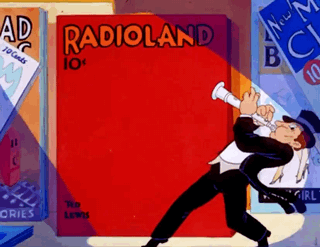
lewis ends his song by doing a variety of very smoothly animated acrobatics, including some wonderfully fluid animation of him twisting through his own legs. toys (reused from toytown hall, among other cartoons... perhaps as far back as the shanty where santy claus lives? it’s hard to keep these cartoons straight!) from child life magazine cheer him on, as do a jovial, giggling hugh hubert reused from the coocoo nut grove, all underscored by a brief rendition of “the merry go round broke down”. the number is complete as lewis takes a bow, with some nice animation of his coattails shaking their anthropomorphic fists in the applause.
elsewhere, more magazine gags: a snake charmer on the cover of “asia” magazine woos a hose on the cover of “better homes and gardens”, prompting it to dance and spit out water. the water rains down upon famed conductor leopold stokowski (who collaborated with walt disney in the making of fantasia a few years later), who dons the cover of “the etude”. the underscore is, fittingly, “september in the rain”, also the title of a friz freleng merrie melody just a few months later. stokowski opens up his sheet music: william tell’s “the storm”. pressing a button, a mini windshield wiper wipes away the raindrops from the music sheets. the rain animation is very well done, especially pooling on top of the music. my guess would be that this is A.C. gamer at work, warner bros.’ effects animator.

the decision to have silence (save for the sound effects of stokowski tapping his music stand and the rain) prelude the oncoming rendition of “the storm” is a powerful one indeed. stokowki directs with all his might, pulling his hair and moving spastically, mirroring the intensity of his music... and then comedic timing swoops in wonderfully well as he bursts into a slightly off tune rendition of the title song, “speaking of the weather”, sparking the music portion of the short. this is probably my favorite song that has a merrie melody in its honor--it’s very catchy, both the original version and the cartoon’s rendition!
quite a bit of animation is reused from previous cartoons in this one, but the decision to reuse animation from a tom palmer cartoon took me by surprise. three women (the boswell sisters) seated at a piano sing the chorus, reused from 1933′s i’ve got to sing a torch song. for those who don’t know, tom palmer lasted a never-ending stint of 2 cartoons at warner bros before getting fired on account of how poor his shorts were. he also introduced the world to buddy, the blandest studio mascot of all time, who dominated shorts from 1933-1935. thanks, tom!
elsewhere, a caricature of lydia pinkham sings affectionately to a caricature of clark gable (reused from the coocoo nut grove), who cleverly dons the cover of “woman’s home companion” magazine. elsewhere, tongue sandwiches stick out their human tongues and “la la lala” along to the rhythm, reused from buddy’s beer garden. the tongue sandwich gag would be reused even as recently as bob clampett’s 1941 goofy groceries--for all i know, he could have been responsible for the original gag in buddy’s beer garden in the first place. you often have to take some of his claims of what he made with a grain of salt, but he did mention that he pioneered the whole “___ come to life” sequences at warner’s, so it serves as some food for thought!

more gags include a teapot (reused from little dutch plate) whistling along to the rhythm, a caricature of greta garbo reading a book and using her shoes as a rocking chair, a dancing lobster whose frequented many cartoons, debuting in how do i know it’s sunday?, and clams clacking to the rhythm. as the song winds to an end, topped off with the cheering toys from earlier (as well as oddly segmented animation of hugh hubert jamming his fingers together in applause), a shifty looking crook (animated by volney white) furtively sneaks out of his post from “the gang” magazine. i LOVE the choice to slow down the beat of the music at the appearance of the gangster--the rhythm becomes much more furtive and cautious.
more volney white animation as the gangster uses a spare blowtorch to burn off the front of a safe plastered on “the magazine of wall street and business”. pan over to a caricature of fictional detective charlie chan, telling the convict that he’s under arrest. the fade to the next scene obscures the animation, but there’s a nice little bit of animation as chan twirls his gun in satisfaction. next scene, the criminal (whose bellows are provided by none other than billy bletcher) gives his confession, obscured by silhouettes--bright pink silhouettes, a jarring yet intriguing design choice. his interrogation takes place, of course, on true confessions magazine.

the judge, also voiced by bletcher, sentences the criminal to life... magazine, a gag that would be reused 9 years later in book revue--my favorite of these book series. i didn’t notice this until the time of writing this review, but the animation of the judge is rather whimsical and fun: he has a tattoo of a pinup girl on his forearm (labeled mabel), and as he jabs his finger through his long beard in the midst of his sentencing, flies flutter out to indicate his age.
struggling against the bars, the prisoner wipes his brow in defeat, until something out of his peripheral catches his eye. i think this may be bob bentley animation--the animation of the prisoner wiping his brow matches up rather well with the scene he did of porky wiping his brow in porky’s railroad. the criminal sneaks behind a wall of magazines, a pan across the scene being our only guide to his movement. with that, he stumbles upon another magazine with prison bars: liberty magazine, where he escapes with ease.

a caricature of columnist walter winchell lives up to his dubbed name of “walter snitchall” as he alerts the public about the prison break, peeking through a keyhole provided by look magazine for his evidence. thus sparks the infamous tashlin montage: overlays of various animated scenes all at once to convey a sense of heightened dramatics and urgency. cop cars, bugle horns, boy scouts on the run, even tarzan and a stampede of animals (reused from the coocoo nut grove and porky in the north woods respectively). as if this cartoon couldn’t date itself further, we’re also met with recycled animation (perhaps from buddy of the apes???) of blackface caricatured natives joining the fight. even animation is reused from as far back as 1931′s ride him, bosko! with a gang of cowboys riding their horses into battle.
time for another caricature, this one being william powell, who lumbers out to a constipated rendition of “the boulevardier from the bronx”. powell starred in the movie “the thin man” three years earlier, and is caricatured as such from his side profile, which is practically non-existent. a dog from “dog world” brags “that’s my pop!” and jumps to join his side.
something you’ll notice throughout this cartoon is the magazine dates: they’re almost all dated october 1946. common speculation is, seeing that this cartoon got a blue-ribbon release in 1945 (which means it was re-released for theaters), that they went back in and changed the dates of the magazines to appeal to the more modern audience. i doubt this is true: this is the same studio who didn’t switch to having full color cartoons until late 1943 to save money--i doubt they’d do something so costly and meticulous as changing the dates on magazine covers.

nevertheless--the convict is now disguised as a baby, donning the cover of better babies magazine. volney white does some nice hat takes as the convict realizes he’s being followed, his baby bonnet twisting up as it attempts to contain the prisoner’s cap from flying through the roof in shock. william powell’s dog sniffs the ground... and we pan back to reveal powell doing the exact same thing, crawling around on all fours. there’s also a GREAT little gag where powell spots something, which is evidently enough trouble to constitute him blindfolding his dog. they continue their search as normal, dog now blindfolded as they cleverly past a line of magazines: the saturday evening post (whose covers i LOVE, especially the ones by norman rockwell and j.c. leyendecker!), literally adorned with wooden posts. the joke being, of course, that powell doesn’t want his dog to stop by the post and pee on it.
some nice, sharp comedic timing as powell and his dog confront the baby carriage where the prisoner is hiding: there’s a pause, and suddenly the convict pops out from the carriage and whacks powell in the face with a baby bottle. cue the climax as the prisoner makes a break for it in a baby carriage, the music score a jaunty rendition of “country boy”. after getting pelted with eggs by a polo player, a cowboy on the front of “western story” magazine lasso’s the criminal, yanking him out of the carriage and dragging him (painfully) by his neck. you’ll notice that on the cover of the magazine, a “cal howd” is credited, referring to warner bros. storyman and short-lived director cal howard.

all of the heroes in their little magazine worlds work together to put a halt to the criminal’s escape: ships fire cannonballs that break the makeshift noose around the convict’s neck, sending him pummeling, spears thrown by the (ugh) racist native caricatures from before cause the crook to face plant, good ol’ saint nick drops his back of toys that wrap around the convict and slow down his run (the animation complex but very well done, topped off by the sound effects of clanking and horns being crushed), greta garbo trips the crook and sends him into a pond on the cover of “country life” magazine, and so forth. i love that rendition of “country boy” as the music! it was also used in earlier 1937 high energy scenes in cartoons such as the fella with the fiddle and ain’t we got fun.

a reprisal of the title song serves as a jaunty underscore as the criminal is launched onto a giant pinball machine, where he’s sent springing around, animation reused from sunday go to meetin’ time. he hits the jackpot, his reward being a sentence to “twenty thousand years in sing sing” by “warden flaws” (a play on lewis e. lawes). hugh hubert taunts the criminal with his signature high pitched giggle that daffy would appropriate into his own signature laugh, aggravating the criminal enough to grab a globe off of the cover of the world almanac, used to sock hubert right over the head. iris out on the convict gleefully impersonating hubert, giggle and all.
this isn’t my favorite tashlin cartoon by a long shot, but it’s also not the worst entry in the book series. rewatching this one a few times certainly heightened my appreciation for the short. though it’s HEAVILY dated, it’s a very clever cartoon, especially if you put some time in to do some research on who these caricatures are or what the magazines are about. i always particularly enjoy analyzing these cartoons chock full of references--time consuming, sure, but you get to LEARN something from them and you get to actively discover and absorb new information you never knew before, and that’s what it’s all about for me.
this is a fun cartoon. the colors are nice and bright, but tastefully so, the music is jaunty and happy (again, i LOVE the original song!), and the animation has its merits. i particularly enjoy volney white’s scenes, as well as the scene of the ted lewis caricature literally bending over backwards to play his clarinet. with that said though, this isn’t a perfect cartoon: some parts feel more cobbled together than others (the scene where the toys and hugh hubert applaud ted lewis’ performance feels oddly out of place), and of course you have reused animation of blackface caricatures... but, in all, it’s an endearing cartoon. there are certainly more boring cartoons out there in this genre.
this is a cartoon i’m neutral on, but i’d say that if you’re curious to see it in action, go for it! if not, you can easily skip it. it’s not a make-or-break type of deal.
with that, here’s a link!
#lt#looney tunes#speaking of the weather#reviews#long post#tashlin#racism m#WHEW that was a tedious one to type
27 notes
·
View notes
Text
Unicorn Chronicles, Book 3: “Dark Whispers,” by Bruce Coville
Whenever people grumble about how long it's been since their favorite fanfic updated, I can't help but smile a little in sympathy. As someone who's read a lot of CLAMP manga, I've grown used to the stutter-stop of hiatuses and discontinued stories that will never be finished. To quote the Princess Bride, "Get used to disappointment". It's just an occupational hazard.
I know people who only read completed stories, but I would have missed out on a lot of great material and works that really matter to me if I followed their example. It also meant that I got really good at imagining what happens next.
So it was a delight to discover that Bruce Coville had actually finished the Unicorn Chronicles when I was busy with other stuff (i.e., life) and there were two more volumes. Coville specifically thanks readers for nagging him about finishing, which is simultaneously #hilarious and #relatable.
Song of the Wanderer came out in 1999, right on the cusp of the Harry Potter boom that shook up the juvenile fantasy genre. (Both series are published by Scholastic.) Dark Whispers came out in 2008, and you can see how much the genre has shifted in the cover art alone:
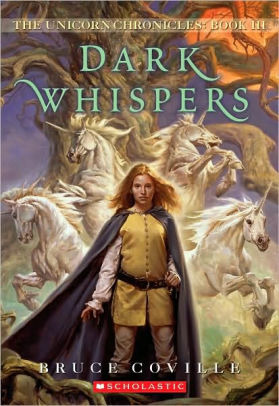
This is gorgeous art by Petar Mesedlzija, but it only tangentially fits the descriptions in the books: Cara doesn't really wear anything like this outfit, and the story emphasizes she keeps braiding her hair to keep it from tangling. She has a sword, but she doesn’t really ever use it?
Furthermore, the layout, design, and chapter headings of Dark Whispers are clearly meant to capitalize on Harry Potter: Grimmwold has a looping signature reminiscent of Dumbeldore's in the opening prologue, for instance. It's a very different feel from the way the first two volumes were presented, and tbh, I miss the old way that has gone the way of the dinosaurs now.
Inevitably, with such a long gap between volumes, Dark Whispers ended up with a very different style and tone than its predecessors. The most obvious difference is that it's REALLY LONG--464 pages in hardcover. Some of this increase in length is attributable to Harry Potter proving that giant fantasy tomes can sell like hotcakes, and some of it is the fact that the storyline is now really big, with a lot of different players moving in different directions.
Inevitably, this means that instead of following Cara's POV for the entire book, as we did in the first two volumes, we are constantly shifting narrators. It's completely understandable, but as a reader, I find it really annoying--like I am suddenly reading an entirely different series with overlapping plot and characters. It's not that this new series is bad, per se, it's just... not what I imagined when I was making up the ending in my head in the early 2000s. I do not know if this disjunct would be so obvious or unsettling to someone who was reading all four volumes together for the first time.
Anyway, so since it's been literally a decade, Coville makes the sensible decision to open with a recap from Grimmwold, in his role as the keeper of the Unicorn Chronicles: unicorns and human hunters are at war; the latter are lead by an immortal woman named Beloved with a personal grudge against the unicorns, and she just got an amulet so she can invade Luster.
In Cara's plotline, she is still coming to terms with the fact that her grandmother, Ivy Morris, was a unicorn in disguise, and is now Queen Amalia Flickerfoot. Her grandfather Jaques is super depressed (because literary references, yo) and also because this is super-weird for him, too. As they prepare for Beloved's assault on Luster, Grimmwold reveals that pages from the Unicorn Chronicles are missing, and that others reveal an unsettling prophecy about unicorns confronting their own darkness and a mysterious figure called the Whisperer.
Another human, Alma Leonetti, comes forth and suggests that the centaurs might know more details. The Queen sends Cara and her friends to investigate, while Jaques and Thomas the Tinker go on separate missions. Thomas does give her a watch that marks the days and also explodes, so you know right away she's gonna need both on her trip. M'Gama the geomancer is trying to determine where and when the Hunters will invade: the date is the forthcoming Blood Moon, but she's still working out the details on the place.
Grimmwold tells the group a story about Alma Leonetti, and how she tracked down the wizard Bellenmore, who opened the gate to Luster for the unicorns. Bellenmore has a snarky talking lizard and great tastes in decorating:
On the mantel above the fireplace stood a row of earthenware mugs with hideous faces. One of them winked at me; another leered and rolled its eyes; a third stuck out its tongue and made a rude noise. Then they began to sing a bawdy song until Bellenmore waved a hand to silence them.
Alma bluffs her way to Luster and eventually persuades the unicorns to keep one of their kind on Earth so humans don't forget true beauty and goodness and the spark is kept alive. The hunters keep trying to kill the Guardian, but they always replace the fallen with a new one and the cycle repeats.
We also learn that Ivy summoned Moonheart to heal Cara as a child, which is what alerted Beloved to her presence, forcing her to kidnap Cara and flee because Beloved wanted the child, too. Ian Hunter was a first grade teacher who had no idea about any of this until Cara disappeared and he was radicalized by Beloved and went through an intensive training camp she's built up for her army.
Meanwhile, Ian is in India, tracking down the Rainbow Prison where Beloved has imprisoned his wife. He makes a deal with a mysterious entity, the Blind Man, trading occasional use of his sight for the knowledge he needs. Beloved's men attack Ian, but he is saved by a street urchin named Rajiv who is eager for adventure, and the mysterious Fallon, who is trying to find a doorway to Luster. The three of them team up and head for the Himalayas to find the doorway to the Rainbow Prison while Beloved's forces pursue them. We learn that Fallon is super-hot and also seeking his best bro Elihu, in a relationship that I'm pretty sure was sexual although it's never stated directly.
There's also a plotline involving the delvers - the evil dwarves we mostly forgot about in Book 2. The King keeps talking to the Whisperer, and sending his subjects to do Evil Things as the alliance with Beloved continues. (The delvers do not love humans, but they hate unicorns and so the "enemy of my enemy is my friend" at least temporarily).
The plotlines converge when the delvers attack M'Gama the earthmancer's house and steal a macguffin and kill Flensa, M'Gama's servant. Cara's party splits up, with Finder and Belle hunting the macguffin while Cara and Lightfoot continue on. Finder is killed (sob) and Belle regrets being a jerk to him. Cara's group is attacked by delvers and she is captured and taken underground. (The delvers either don't know Beloved has an amulet already/don't care/want one for their own purposes.) Cara tosses the amulet into an abyss when it fails to transport her to earth, and she is imprisoned in the dungeons with a delver dissident who has had his name ritually stripped from him for defiance.
Cara renames the delver "Rocky" and the Squijum shows up with the amulet and steals the key. They meet up with Grimmwold, and escape. They also encounter the gryphon Medafil, who is lost below ground, only to wake a monster known as the schwartz, a Terminator-like blind dragon that never gives up pursuit. Cara defeats it using the expanding light sphere from Medafil's nest, and they emerge in the centaur's valley, where Belle is waiting for them with the news of Finder's death.
The centaurs are standoffish, but eventually Cara persuades their leader Chiron to spill the beans: after the war with Beloved began, the unicorns decided to expunge all the darkness from their souls with the aid of a magician named Elihu (hi!), which gained sentience and has been egging Beloved on ever since. It's also corrupted the delvers,which is why they hate unicorns so much. In exchange for the info, Cara agrees to mercy-kill Chiron, which none of the centaurs can do for personal reasons. Cara reports this story to the unicorns, who are all :shrug emoji: about it.
Meanwhile Ian and company are stuck in the Rainbow Prison, the Dimblethum is being tormented by the Whisperer, and ends up taking the macguffin the delvers stole and placing it at the Axis Mundi, the world-tree of Luster, so that Beloved and her forces can enter there. Lightfoot tries to stop the Dimblethum but isn't in time. And the book ends on the seriously metal note of Beloved opening the portal beneath the blood moon and invading Luster with her army. *cue 'Bad Moon Rising'*
[Which, I may note, is pretty much where the LAST BOOK also ended.]
SO. That was a lot.
Once again, the core group of characters from Book One gets broken up. Thomas the Tinker gets sidetracked pretty quickly and isn't seen again; the Dimblethum gets a few brief sequences, but doesn't do much until the end. Lightfoot and Cara are separated fairly early on and don't have much time together, though their musings about their sudden familial connections at the beginning are nice, even though Cara also keeps shipping Belle with Lightfoot. Lightfoot himself doesn't get to do much, Finder dies, and Belle is likewise sidelined by the narrative for a decent chunk of the story. Coville also keeps emphasizing that Lightfoot is a Prince, which just grates on me, too.
I would also like to see more of Cara? She has plenty of scenes, but after two books of focusing solely on her, it's so strange to suddenly be jerked in different directions and it makes me grumpy.
It's great to see Medafil again, but I found the whole delvers/underground plot to drag on too long for my tastes. I'm glad Coville brings back that one delver from the first book who let Cara go because he thinks (rightly) his king is batshit crazy.
I like Alma Leonetti's story, but it feels unrelated to the plot, so I'm not entirely sure why it's there. I think it was originally a stand-alone short story, and I think it's better suited as one, because I can't figure out what its narrative purpose is. Or is it just that Grimmwold is contractually obligated to tell at least one story per book?? Or maybe this is something that will pay off in Book 4.
Ian Hunter's story basically bores me, and I found that whole subplot extremely tedious. He's been more or less retconned to be sympathetic and a victim, and I just don't know how I feel about that.
I HAVE SUCH MIXED FEELINGS ABOUT THE BIG REVEAL. On the one hand, it's a great twist to see the psychological shadow as the literal villain; on the other hand, it takes away some of the delvers' and Beloved's agency as villains in their own right because they're now Pawns of a Bigger Bad. It also just seems like such a weird thing for the unicorns to do--and maybe that's a way of making them more alien, but I don't know.
Coville explicitly uses the word 'hubris,' so it also feels weirdly victim-blaming to me because the unicorns are doing it to themselves (and this isn't just a war, but genocide we're talking about here!). For better or worse, this twist muddies the black and white/good vs. evil paradigm into shades of gray: the unicorns are beautiful and good but also arrogant assholes; Beloved is homicidal but also in terrible pain; the delvers are misunderstood and need to be embraced rather than ignored.
Alma Leonetti consistently delivers the best lines - I guess she's taken over the role Ivy Morris used to play, since Ivy is now a unicorn:
"Perhaps the unicorns need to try to recover some of what they have lost?... You face a dedicated enemy who has shown no mercy, one who will stop at nothing to destroy you. And what have you done? Gathered together, which is good. Prepared to defend yourselves, which is good, too. But is it enough? How fiercely are you willing to fight to save your lives? How strong can unicorns be? ... Maybe you need to take in some of that darkness you once released."
I remember feeling oddly disappointed on my first reading, which unfortunately persists on re-read. This story has now moved in a very different direction from the one I expected, and while that's not necessarily bad, it is unsettling and strange. As I mentioned earlier, some of that might just be that the final result doesn't match the story I made up in my head; or it could just be the inevitable result of such a long gap between books and the changes in the fantasy market post-Harry Potter. I don't know.
(I wish I had written down my thoughts about an ending--aka fanfic--because while I could write one now, it’d be reacting to canon, rather than creating it.)
Either way, major kudos to Coville for writing this book, because I had assumed the series was dead and would never be completed, and he fucking did it. That’s such an inspiration, honestly.
6 notes
·
View notes
Text
Xenoblade Chronicles: Definitive Edition, complete.
Spoilers below with my thoughts on the game.
Man. Just...man.
I bought Xenoblade Chronicles: Definitive Edition on May 29, 2020, the day of it’s release. Made sure to get a physical release. Had to wait a bit because I was finishing up the Trials of Mana remake. Took about 2 and a half weeks if I recall. Once I was done in mid June, I was ready to jump in.
I started with Future Connected. Loved this additional epilogue. Was great to finally explore the Bionis’ Left Shoulder after hearing for years about it being unused in the original game. The new music is awesome and reminiscent of the Torna DLC’s OST in Xenoblade 2; lots of jazzy and rocking tunes. More Melia is always great too, and Kino and Nene are great additions.
I finished Future Connected in early July, and hopped into the main game a day later.
It was an absolute pleasure to revisit the original game in high definition. Seeing everything upscaled and more detailed was pure eye candy. The new character models are great too; I’ll admit that I couldn’t get used to Reyn’s character model at first, but I grew to like it over time.
Everything was as enjoyable as I remembered it, and even more enjoyable in many aspects. The battle system is as nice and fluid as I remembered it. The sidequests are nice and engaging (even if many of them are fetch quests; I honestly don’t care about that though as I still like them regardless). Restoring Colony 6 was enjoyable; this was my first time restoring it to completion!
The menus are so much more improved from the Wii version: equipping characters and mixing and matching their outfits is fun along with equipping gems to them. Although there is a lot to keep track of with the skill trees, arts, and other micromanaging aspects of the game, I found it not overwhelming nor unenjoyable. Building the party up over the course of the game is one of the best aspects in my opinion; it really drives home how much everyone grows throughout the journey.
And the story...for the love of Bionis...what a story. The way it builds from Shulk and Fiora sharing lunch on a peaceful overlook in a quaint town, to the masterful ending sequence of the game seeing the world reborn is one of the most emotional experiences ever. Seeing everyone bond together through each struggle, each triumph, and each heart-to-heart is captivating. And what an eclectic group of adventurers too: members from almost every race except for the Machina join the party (I do wish Vanea was added to the party as the eighth member, but alas, I guess it was too late in the game’s story once you got to Agniratha). I just love the dynamics of each and every character interaction and seeing the world come alive through this cast of characters.
But I have to take a moment to bring up the ending sequence to Xenoblade Chronicles: I consider the moment you step through the transporter to access the Prison Terrace to face Dickson one last time to the final cutscene in the game where Shulk and friends enjoy the reborn world to be one of the most masterfully written, most emotional, and absolute greatest story sequences ever told in any piece of fiction.
Finding out that you’re walking around in the Solar System is one of the biggest eye opening and most aesthetically beautiful moments in gaming. And then the final battle against Zanza, when you hear the first final boss song, called Zanza the Divine, and then hear the second final boss song, the God Slaying Sword...man...MAAAAAAAN...it’s just beyond awesome. A YouTube comment describes the two songs best:

At the end, you’ve become the final boss. You are Zanza’s worst nightmare. Shulk ends Zanza’s existence and decides (along with Alvis) to hand the keys of destiny over to mortals. Who cares about having immortality and absolute power? Let’s just have fun, go adventuring, discover things in a new and boundless world and have positive surprises! That sounds like a much better world, and Shulk and company knows it.
Alvis says it best: “Shulk, this new world is boundless. It is home to not only you, but many forms of life. I can see it... In this world all life will walk towards the future. Hand in hand...“
And I’m glad you get to experience that world in Future Connected, if only in one region of the Bionis in the reborn world.
Anyway, I’ve rambled long enough. If you’re reading this you likely know how good of a game the first Xenoblade is. I consider Xenoblade Chronicles a masterpiece, and although the Wii version had very few minor flaws, the Definitive Edition corrects them. I love both versions for different reasons, but I’m so glad the Definitive Edition exists.
And I may have cried a bit the moment Beyond the Sky starts playing in the final cutscene. May have.
I also like how the Definitive Edition adds the special title screen once you’ve completed the main game; Kino and Nene get added once you’ve beaten Future Connected. It’s such a beautiful scene with the party members from both games (this particular screenshot that someone took only has the party from the main game).

Xenoblade Chronicles: Definitive Edition is a masterpiece. I cannot recommend this game enough to any fan of video games as a whole and especially JRPG fanatics. This was my second playthrough of this game (once on Wii, once on Switch), and I already see a vision of a third playthrough in my future. Unfortunately, because of my current living situation, I had to play most of the game, including the ending sequence, in handheld mode. One day, I’d like to experience the end of the game on a nice super high definition TV. Perhaps one day it’ll happen if I grab hold of the future.
I didn't 100% the game, but I got very close. I'd say I probably did about 95 to 98% of it. Story was of course finished, but some of the extras I just couldn't do this time around. It’s just extra motivation to play it a third time in the future.
Oh, and Alvis is the best character. No one can convince me otherwise.
8 notes
·
View notes
Text
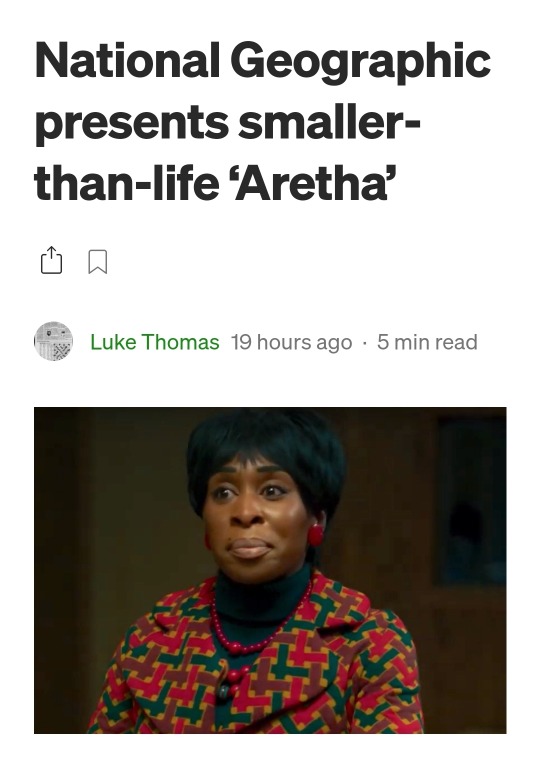
Aretha Franklin was larger than life. Her voice, her physical presence, her personality, her place in musical history. Everything about Aretha was big. To appropriately portray the scope of her story, and everything she represented, the treatment must be larger than life.
National Geographic’s 8-part series, “Genius: Aretha” does the exact opposite.
To begin with, there’s a reason they call television “the small screen.” It’s not a medium for epic storytelling, or anything with significant scope. The way the series is shot feels very much like daytime television, rather than a cinematic experience. But that alone isn’t what makes this story feel so small.
The opening title sequence of each episode contains music that sounds like a midi track from an old video game — a bizarre musical choice to set the tone for a story about Aretha Franklin, a brilliant and inspiring musician who was named the #1 greatest singer of all time by Rolling Stone Magazine.
Suzan Lori-Parks’ script diminishes The Queen of Soul to a mere caricature. The dialogue is so poorly written, it becomes a distraction to the story. Throughout the overlong show, Parks takes tangential details and tries to make them absurdly momentous. And worse, she reduces some of Franklin’s grandest moments into side notes, or skips them entirely. For example, we see Aretha (barely) react to the announcement of Dr. King’s death. But why did they gloss over the fact that Aretha sang at his funeral? Instead, the episode included a fictional scene of Aretha and MLK flirting during a smoke break. A classic example of sacrificing an iconic moment, for a silly (and untrue) scene in its place.
The entire show feels like an effort to confuse the audience as to what time period it’s supposed to be in. This is partially due to the scattered direction from Anthony Hemingway. The flashbacks are confusing, in part because some are in black and white, while others are in color. Stylistically, the black and white treatment never works because the picture looks as bright and clear as if it was shot yesterday. Nothing else was done to make the “old” scenes look old.
Another authenticity problem is the gospel music sung by young Aretha. While Shaian Jordan has a lovely voice, it is a contemporary R&B sound, and does not remotely resemble the style in which Aretha Franklin sang as a child. Her voice is much smaller than young Aretha’s, and yet audiences respond with rapturous applause as if she just brought the house down. This is distracting, to say the least.
Overall, the acting leaves much to be desired, and is not helped by the lackluster script. Each actor’s delivery feels like they are reciting lines. The pacing as a whole is painfully slow, yet each individual scene feels rushed.
In life, Aretha was surrounded by celebrities from an early age. Her father was a famous minister, and they had countless famous friends. Even from a young age, some of Aretha’s closest friends and neighbors grew up to be stars as well. So, to properly tell Aretha Franklin’s story, you need a glittery cast of A-list talent. NatGeo fell painfully short in this department, as no one is actually a star.
The closest thing to an A-list celebrity is Courtney B. Vance, who has enjoyed an illustrious screen career. But even he is sadly out of his element playing Aretha’s father, the iconic Rev. CL Franklin. His portrayal feels like a caricature, and much of his story arc is straight from the salacious rumor mill.
Unfortunately for everyone involved, NatGeo’s worst error was the miscasting of British musical theater actress Cynthia Erivo as Aretha Franklin.
Perhaps most obviously, Erivo simply does not possess the physicality to play Aretha at any stage of her life. Her stature is far too small, and her costars tower over her in most scenes. Aretha had unique presence both onstage and off. She was a commanding figure — a force — and yet she had the most graceful way of moving. Her gestures were understated and subtle. Erivo’s movements are hurried and harsh, and her physical presence lacks the authority of Aretha.
One of the most distracting elements is Erivo’s speaking voice. Aretha had a high, breathy, flirtatious voice, with a specific lilt in her cadence. For reasons unknown, Erivo speaks in a low, emotionless monotone, which is reminiscent of her previous characters, Celie (“The Color Purple”) and Harriet Tubman (“Harriet”). It would seem that Erivo has one American accent in her arsenal and uses it with each American role she takes on. Perhaps the most difficult moments to watch are when she accidently slips back into her British accent, taking the audience fully out of the scene. Why no one on set caught these major gaffes is beyond comprehension.
Erivo’s character development completely misses the mark. Aretha had a strong personality, but was also shy, coy, demure, feminine, and cool at the same time. Erivo’s portrayal is surprisingly one-dimensional. It would seem that her only view of Miss Franklin was “angry diva.” But Aretha was far more than a diva, and when her “diva” came out, it was often coupled with a wink and a nod. Aretha loved to laugh and had a wonderful sense of humor. Erivo’s Aretha is painfully void of comic relief, completely ignoring Franklin’s playful and acerbic wit. The one instance she attempts to show this side (telling her band a joke about a chicken), it falls completely flat.
While Erivo’s singing is strong throughout, it never reaches that spine-tingling level of Aretha’s unbridled delivery. Instead, it feels like a carefully rehearsed karaoke imitation. Unlike Andra Day’s recent tour de force performance as Billie Holiday (“The United States Vs. Billie Holiday), Erivo never manages to get lost in the character, even during her best musical moments.
In addition, many of the musical moments would appear to be added after the fact, just to remind the audience that this is still Aretha Franklin’s story we are watching.
Arguably the biggest letdown of this entire endeavor is the song selection. NatGeo did not secure the rights to Franklin’s most beloved songs in her catalogue. So what we get here is a string of lesser known songs from Aretha’s repertoire — and often, songs more closely associated with other acts (Sam Cooke’s “A Change Is Gonna Come,” Otis Redding’s “Satisfaction,” Dusty Springfield’s “Son of a Preacher Man” and Diana Ross’s “Reach Out and Touch”).
Before Miss Franklin died, it’s been said that she specifically requested not to have her story told on television. (Instead, she famously asked Jennifer Hudson to bring her story to life on the big screen in MGM’s “Respect,” due in theaters this August.) Aretha knew what National Geographic and its showrunners did not — her story is larger than life and should be treated as such.
5 notes
·
View notes
Link

High-speed 3D shooter Wing of Darkness will launch digitally for PlayStation 4, Switch, and PC via Steam on February 25, 2021 worldwide for $29.99 / 2,980 yen, publisher Clouded Leopard Entertainment and developer Production Exabilities announced. It will support English, Japanese, Chinese (Traditional and Simplified), Korean, French, Italian, German, and Spanish subtitle language options, and Japanese audio.
In Japan and Asia, Wing of Darkness will also be available in physical standard and limited editions for $29.99 / 3,480 yen and $84.99 / 8,980 yen, respectively. The limited edition includes a special box, the original soundtrack, pins, a crest, an acrylic figurine, a B5 sticker sheet, visual fan book, and one last item to be announced.
Here is an overview of the game, via Clouded Leopard Entertainment:
■ History
This project is a labor of love by a small, yet spirited team of game industry professionals whose vision is to deliver the highest-quality entertainment.
Production Exabilities’ debut release is a 3D shooter focusing on stunning visuals, with a moving musical score and story to match. The game is comprised of two elements: an exhilarating action segment, followed by a cutscene depicting the inner perspectives of the two main heroines.
This high-profile Japanese indie game, which has already garnered considerable attention at various gaming events, is finally ready for simultaneous worldwide release.
■ About the Game
Between high-octane action sequences and dramatic cutscenes, the Frauleins’ war unfolds…
In Wing of Darkness, you play as a Fraulein: a young woman battling against hostile invaders known as Blankers. The game is comprised of two elements: an exhilarating action segment, in which the player flies through beautifully rendered skies, shooting down enemies with a never-ending supply of ammunition, followed by a fully-voiced cutscene wherein the two main heroines act as the narrators, depicting the war from their perspectives.
—A thrilling, action-packed adventure awaits!

—The story unfolds from the perspectives of two warriors.

■ Story
Young women prepare to take flight. For themselves, and for the whole world…
An unknown enemy, the Blankers, have completely changed the nature of combat. Now, war has become a game for the survival of mankind.
Nothing can defeat the Blankers except the Held System, a state-of-the-art weapon, and the Frauleins, the young women are uniquely disposed to using them.
This means that Frauleins are humanity’s last hope. They must be prepared to face their greatest fears as they take flight against the enemy.
If they don’t fight, mankind will be wiped out. But in doing so, the Frauleins will lose something very dear to them…
This is a story of what it means to truly be human, told through the eyes of two brave young warriors.

■ Action Sequences
Take to the skies as a Fraulein!
Simple Mechanics
Enjoy zipping through the sky in all directions with simple gameplay controls.

Unlimited Ammo
Ammunition replenishes itself gradually over time. Choose your weapon before each mission and experience the exhilaration of shooting down powerful enemies without any restrictions.

Stunning Visuals
The various missions depict stylish aerial combat with laser weapons and missiles. The sky’s the limit!
Cutscenes
A tale of war and two girls.

Fully Voiced Story
Cutscenes take place before and after the action sequences. The story is told in a reminiscent narrative that alternates between the perspectives of the two main heroines, Klara (voiced by Kiyono Yasuno) and Erika (voiced by Chihira Mochida).
Two Frauleins
The story begins when two young women from complete opposite backgrounds meet.
At first, they dislike each other, but they eventually grow to respect one another, coming together to fight against the unknown threat of the Blankers, as well as the mystery surrounding the Fraulein military program.
■ Limited Edition Physical Edition

The exclusive limited edition physical edition includes:
The full opening and ending songs sung by the two lead voice actresses.
An original soundtrack containing voiced stories depicting the daily lives of the two protagonists.
A visual fan book with many models of the two main characters and enemy aircraft, as well as a lyric sheet and an original voice drama, all of which will be fully localized into traditional Chinese and Korean.
Patches and pins bearing the in-game squad emblem.
A variety of other bonus items only available in this version.
View a new set of screenshots, artwork, and a beauty shot of the limited edition at the gallery.
#Wing of Darkness#Clouded Leopard Entertainment#Production Exabilities#3D Shooter#PS4#Nintendo Switch#PC#Gematsu
7 notes
·
View notes
Text
Magnolia
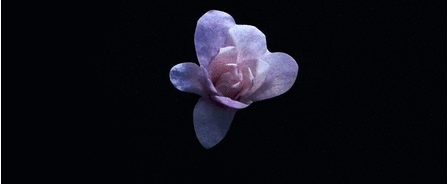
I don’t know much about Magnolia or Paul Thomas Anderson, but I do know that it takes someone paying me to get me to watch a 3-hr+ drama that doesn’t star Kate Winslet, Leonardo DiCaprio, and a really big boat. This is one of my mom’s favorite movies which is why she requested it for me to review. It’s packed with a balls-to-the-wall star-studded cast (Tom Cruise! Julianne Moore! Phillip Seymour Hoffman! John C. Reilly! William H. Macy! Felicity Huffman!) and I’m genuinely excited to see how they all fit together. Cause they have to all fit together in some coherent way, right? Well...
Do you remember in Sorry to Bother You when the Equisapiens came out and things just took like...a real turn? That’s kind of what this was like. Whereas StBY pushed a thought to its most extreme, but logical, conclusion, what Paul Thomas Anderson has done here feels like a magician doing a lot of impressive illusions - sawing a lady in half, making a motorcycle disappear, pulling smaller things out of bigger things - and then for his final trick, walking onstage amidst a grand plume of smoke, dropping his pants, taking a gigantic shit, and then saying, “You’ve been a great audience, thanks a lot and goodnight!” It’s not like you can say the experience was BAD. Everything up to the finale was a really great time! But when you’re left on a note that is that bafflingly odd, it kinda colors the way you’ll remember the whole thing.
Magnolia is the story of one long day in the life of 12 people living in Los Angeles who are all connected via an extensive web from acquaintances to married couples to parents and children to paid caregivers and beyond. It’s a day that has the same kind of ups and downs as any other day until it, well, turns into something else entirely. I’m not sure how else to explain it, but if you want to know more, spoilers will be spoiled below.
Some thoughts:
Patton Oswalt cameo! I am a massive fan and thought I knew his whole filmography and OMG how did I not know that he was in this!!
Ok, in spite of my skepticism this entire opening sequence about coincidence had me hooked IMMEDIATELY. Like, this is some damn good storytelling, if this were a novel, I would not be able to put it down - that pull, that’s what it feels like.
Am I the only person whose encyclopedic memory of character actors/roles gets distracted when they see someone from something that is wildly disparate compared to the role you’re currently watching? For example, I had to pause the movie and confirm via IMDB that I did just see Professor Sprout from HP scream “Shut the fuck up!” at her husband while brandishing a shotgun.
Would people really recognize a grown ass man from being a successful child game show contestant? I’ll tell you the answer, no they wouldn’t, because no one realizes that Peter Billingsley (aka Ralphie from A Christmas Story) is the head of the elf production line in Elf.
I knew this was a stacked cast, but holy SHIT this is a stacked cast. If I had $1 for every fantastic character actor I recognize in this, I would have at least $37, and these are people in the film who have maybe 2-3 lines each. It’s a deep bench is what I’m saying.
This makes me miss Phillip Seymour Hoffman so, so very much.
Watching PSH care for and be so compassionate and gentle with his hospice patient, Earl (Jason Robards),makes my heart ache terribly. All of the people who have been unable to perform this kindness, this type of compassionate care for their closest loved ones as they lie dying in isolation of Covid...it’s overwhelming.
OMG I’m counting 1, 2, 3, 4, 5 Very Good Dogs in the old man’s house!
I know Scientology is evil and he’s undeniably a complicated and morally grey person. I know all that. But goddamn I just love watching Tom Cruise COMMIT. Particularly when he commits to just absolute fucking sleazebag slimeballs. And boy oh boy is Frank Mackey an absolute fucking sleazebag slimeball.
Related - I know Frank looks like Tom Cruise, so he could get people to sleep with him no matter what, but I honestly feel like as a human being, this flesh suit is WAY more attractive balding and fat in Tropic Thunder than he is in this shiny brown shirt/leather vest/long hair combo.
I’m getting an uncomfortable vibe about these black characters being written by an artsy white dude, because I don’t know any young black kids who want to hang around with cops and offer up information about who committed a murder in their building. In fact, the way all of the black characters are treated in this film - as liars, criminals, the disingenuous “main stream media,” and thieves - feels rooted in some racist ass bullshit. We see a lot of nuance in our white characters, but even in a film that has, shockingly, more than one key black role, we don’t get that spectrum or nuance.
There is nothing I would love more than to learn that Frank Mackey is 1) gay 2) impotent or 3) both. He’s so disgustingly over-the-top misogynistic, it honestly feels like it should all be a complete act.
I confess I am on the edge of my seat trying to figure out how all these narrative threads tie together. It’s compelling as hell, even though half the time I don’t know why these people are having these long, meandering conversations. The pacing feels so deliberate, like a puzzle coming together. There’s real craftsmanship in how every scene is plotted to feel connected rather than manic or disjointed.
This pharmacist is being unprofessional as hell. Judgy McJudgerson, mind your fucking business, Julianne Moore’s father is dying! [ETA: ope, that’s embarrassing, Earl is actually her husband.]
NO THE DOG IS EATING THE PILLS OH NO VERY CONCERNED ABOUT THE DOG.
I think I knew this, but this soundtrack is fantastic. All Aimee Mann and Supertramp, and Jon Brion’s score is this thrumming, anxious thing full of strings that underscore all these nervous conversations, and then it shifts into these low, mournful horns when things start to take a turn and everyone is reaching their lowest points.
I love this interviewer (April Grace) who is taking Frank (Tom Cruise) to task. I think it’s particularly noteworthy that she is a black woman, because the kind of misogyny Frank peddles is rooted in white supremacy.
Stanley (Jeremy Blackman) is breaking my goddamn heart here. I think he and Phil (PSH) are my favorite characters.
Jim (John C Reilly) is the perfect example of how even a cop with the best intentions, with absolute kindness and love is in heart, is abusing his power and sexually harassing a woman he encountered in the line of duty, who is eager to appease him because she doesn’t want to be charged with a crime. This movie reads a LOT differently than it did in 1999.
I normally really love Julianne Moore, but she is a screeching mess in this. I can’t stop staring at her mouth and all the contortions it makes as she delivers every line in hysterics. She’s one of the few weak spots for me here.
Listening to Frank go on his whole diatribe about what society does to little boys to break them and victimize them HAS to be the source of where Keith Raniere got at least half of his NXIVM bullshit. Like, some of these points are word-for-word.
Also if Frank makes as much money as he seems to, there’s no way he would drive a shitty Saturn sedan.
It feels like the common thread of this movie is everyone is terrible and cheats on their spouses, and you should come clean when you get cancer so you can die peacefully. Weird moral, but ok.
If Jim is a cop, how does he not see that this woman he’s interested in (Melora Walters) is coked out of her mind?
Y’know for being a quiz kid, Donnie (William H. Macy) sure is kinda stupid.
I confess I’m not taking many notes throughout this because I’m just kind of sitting breathlessly still watching all these conversations unfold because I am on the edge of my fucking seat to find out how all this is gonna come together.
Secret MVP of this movie is the mom from A Christmas Story (Melinda Dillon) who is giving the performance of her goddamn life as Jimmy Gator’s wife.
Did I Cry? On the surface it appears ridiculous, but when Tom Cruise is having his breakdown at his dying father’s bedside, I admit, that really got me. If you’ve ever been faced with that kind of hysterical, I-can’t-believe-this-is-happening, it feels like the whole world is ending kind of shock and hurt and anger, that’s what the crying looks like.
Are those......frogs?? That landed on Jim’s car? It’s raining fucking frogs???? OK for those of you sensitive to frog harm, this movie is going to take a real hard left turn for you, because I swear that came out of NOWHERE.
Um.
What.
Pray tell.
The fuck.
The climax of this movie - is when literal frogs rain from the sky.
And we finally got resolution about the dog, and the dog DID die, and I’m pissed about it. It’s offscreen but still.
I'm sorry - I know I’m fixating. But how is it possible that I knew about all the characters performing a sing-along to Aimee Mann’s (excellent) song “Wise Up” but I did NOT know that the climax of the film involves literally thousands of frogs falling to their death from the sky? How is that something that escapes entry into the cultural zeitgeist? I’m with it, you guys. I have been Very Online for over a decade, and before that, I read a lot of Entertainment Weekly, and like it just seems that this is something that pop culture really should have told me.
I think the funniest moment of this movie might be the credits in which I discovered that not only is Luis Guzman playing a man named Luis, he’s actually playing himself. I don’t know why, but I can’t stop laughing about it. That was a 189-minute setup to one dumb punchline.
I think I loved this movie but I don’t quite know. The frog thing really threw me. What I’m taking away from it is that even when it doesn’t feel like it or seem like it, we are all connected to each other, always, in ways we can’t see or know. As Wife astutely pointed out, it’s reminiscent of the pandemic - we’re all in the same storm, but we each have our own boats and our own experiences within that storm. And it’s kind of nice to remember that right now, that connection still exists even when it feels so far away. Just not if you’re a frog I guess, cause they really got the short end of the stick here.
If you liked this review, please consider reblogging or subscribing to my Patreon! For as low as $1, you can access bonus content and movie reviews, or even request that I review any movie of your choice.
#121in2021#magnolia#magnolia review#paul thomas anderson#tom cruise#julianne moore#phillip seymour hoffman#John C Reilly#william h macy#movie reviews#film reviews#patreon review
5 notes
·
View notes
Text
Final Fantasy Review

Year: 1987
Original Platform: Famicom
Also available on: Nintendo (NES), GameBoy Advance (Final Fantasy I & II: Dawn of Souls), PlayStation One (Final Fantasy Origins), PSP (Anniversary Edition)
Version I played: PSP
Synopsis:
The world is in danger. Four monstrous fiends, each corresponding to an element of nature, have wreaked havoc on the world, causing each of the four elemental orbs (in later remakes, crystals) to turn dark. Four Heroes of Light, each holding their own orb, meet and band together to take on these fiends and restore nature to its proper balance.

Gameplay:
The original game introduced the Job System. The six jobs are Warrior, Thief, Monk, Black Mage, White Mage, and Red Mage. Each have their own stats. You are free to name each of your heroes. Later on the game, each job can be upgraded.
We are introduced to a classic setup of turn-based combat. Final Fantasy was notable for being the first video game RPG to show your characters on the right and the enemies on the left; all previous video game RPGs had a first-person view with the enemy directly in front of you.You choose your action between Fight, Magic, Drink, Item or Run. Then the enemy takes their turn.
It’s a simple system that at the time was already well-known. It was really the Job System that intrigued players. Black Mages perform destructive magic, White Mages heal and restore, Warriors are the powerhouses, Monks deal damage without weapons, and Thieves can run from battles successfully (they cannot steal, as later games would introduce that).
The game can be quite difficult on the original Famicom and NES. It was made at a time when technology was limited, so developers had to make the game harder so that people spent more time playing it. There’s a gaming term that I’ll be using in many of these Final Fantasy reviews called “grinding”. Grinding is when you end up having to run around and fight monsters for the sake of leveling up your characters. There is a lot of that in this game, as well as the early Final Fantasy games in general.
Unlike games today, the direction isn’t fully laid out. You are thrown into the world and wander about from town to town to figure out where to go next. Instead of games like today where other non-playable characters (NPCs for short) tell you what to do in cutscenes and whatever, you actually have to approach the NPCs and find out the information. The overall effect is more open-world. You walk across fields and oceans and deserts. There are caves and other secret places to find more items.
From a modern gamer’s perspective, the exploring can be quite bare and – for lack of better word – boring. The remakes, like the PSP version that I played, brightened it up with updated graphics. They also added a couple extra dungeons. I actually spent time in those extra dungeons believing they were part of the story, appalled by how difficult they were, when I later found out they were extras put in for the PSP version. That has happened a lot to me with remakes of old RPGs (Chrono Trigger for the DS, another example). A little more obvious sign would have helped to make me realize that I didn’t need to finish those extra dungeons.
The pace is definitely slower than the other Final Fantasy games. Most of your time is spent grinding. Grinding can sometimes be a wary word when talking about video game RPGs. If an RPG is too boring or tedious, grinding is the last thing you want to hear. But even when an RPG is fun, grinding means that you need to spend time battling enemies, and that means hopefully you don’t have a huge backlog of other video games. It's probably why I never got around to finishing the original NES version on an emulator. Once and a while I'd be pumped up about going through with it but then as I played I just. . .got distracted by other video games that I wanted to finish.
You definitely need time and patience.
The most aggravating thing about the original version (Famicom/NES) is that if your character is set to attack an enemy but another one of your characters defeats it first, that character attacks nothing but air when it's their turn. It was a very annoying issue that they fixed in all subsequent remakes.
When comparing the original to any other version, the original always is the best way to experience the game. It can also be the hardest and most time-consuming. You would need to pay attention to this game entirely and not be distracted by anything else.
The PSP version is watered down. I found it infinitely easier than the NES version. I actually played them side-by-side to figure out at what point the difficulty branched off. Right away when you venture to save Princess Sara, I realized that the PSP version gives more XP per battle than the NES version. Hence, you have to grind more in the original version.
Graphics:
Everybody loves some 8-bits, but let’s be honest here – there’s a whole lot of black empty space going on when you battle.

But hey, that was due to the limitations at the time. Battles may seem more boring to you due to the lack of detail to catch your eye.
The later remakes added a floor or ground where appropriate. The PSP remake did a good job of giving a facelift to the original, as shown below. It has this cute, rounded feel to the characters.
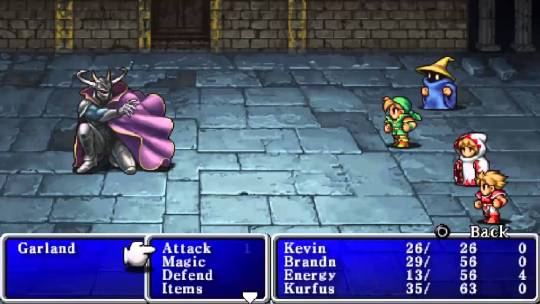
(My favorite battle background was in the final battle.)
The opening FMV sequence is ripped straight from the Playstation One remake. That didn’t age well. It’s awkward as hell. Want to see how awkward it looks? It looks mad awkward. Don’t say I didn’t warn you. Just look it up. I don’t want to sully this post by posting a screenshot. In my opinion, they should have created a brand new opening FMV sequence for the PSP version.
Story:
The first several minutes of the game acts as a prologue. The Four Heroes of Light save a princess - Sara - from the clutches of Garland, and then the King of Coneria allows a bridge to be built for them to enter the world and save it. It’s not until that bridge is built that the game truly starts and the title screen actually displays – much like a late opening title in a movie.
In retrospect, saving a princess probably seemed like the most common trope in video games throughout the '80's. Gamers would have been used to it by then. That short prologue acts like a trope-breaker. The average gamer would have probably expected the game to be like Mario or Zelda. Oh yeah, save the princess from some evil fiend, okay, got it. They would have then maybe been perked with interest when they "defeated" Garland so quickly, and then when the King of Coneria lets them pass into the world and the title screen opens up with the theme song, they maybe were like, "Ooooh. NOW it starts." Final Fantasy then plunged them into a wide open world.
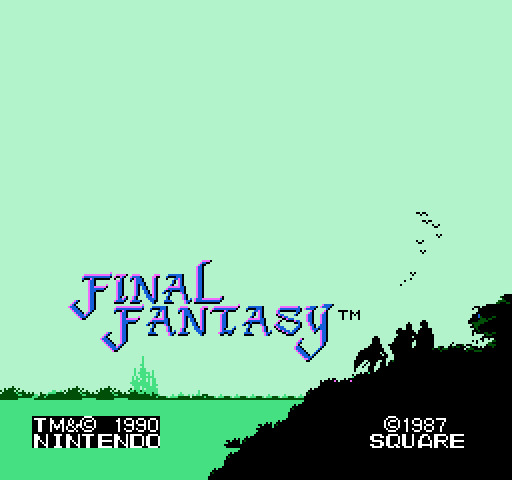
The bulk of the story is mostly comprised of self-contained incidents. You run into someone who needs help with a thing so you do that thing and then you’re on your merry way again. You know what would be a great adaptation of this game? A Netflix series. It’s very episodic. First you deal with these pirates led by Bikke, then get a ship to sail across the land and go on a sort of delivery quest for a crown, a crystal eye, an herb, a magic key, until the main story picks up with defeating the Four Fiends and bringing light to the darkened orbs.
There's no real huge spoiler other than the time travel paradox at the end, which had me wracking my head a bit. It's quite admirable that a game this early in video game console history produced a higher concept plot involving time travel.
Music:
Composer Nobuo Uematsu created a legendary score that immediately became on par with the Mario and Zelda theme songs. The Prelude/Crystal theme – the harp-like scale that we are all familiar with – was actually composed last. Uematsu had complete the score when Sakaguchi approached him at the last minute realizing they needed music for the game’s introduction. None of them had any idea that the theme would become a staple for Final Fantasy.
Due to the technical limitations at the time, you can imagine that the soundtrack is limited, but even so it was still quite expansive for its time. There are several individual tunes for dungeons, for sailing your ship and for flying your airship. The map theme will have you humming it without realizing it.
Uematsu drew his inspiration from two sources – classic rock and living in Shikoku, an island off Japan. The melodic world map theme in Final Fantasy (and the rest of the series) derives from the picturesque memories he has of the island. The town theme is reminiscent of the sleepy villages – as he was never a city person. Meanwhile, the battle theme has undertones of rock music.
There’s only one battle theme, even when fighting bosses and the final boss, but the amazing thing is that it never gets old.
Final Fantasy games are known for their great battle songs. The opening bassline always gets you in the groove to fight. You’re fighting but want to sing at the same time. Maybe that’s the brilliance of Uematsu; because of the fact that you need to grind many times in these old Final Fantasy games, he created a tune that you wouldn’t get tired of because it’s not so serious or mundane.
Not to crap on other great developers, but other video game RPGs at the time of Final Fantasy didn’t quite have memorable battle music. Just look up the battle theme to the first Dragon Quest game (released before Final Fantasy). You can imagine how that simple tune could get old really quick. I could be pulling this out of my ass, but after Final Fantasy, it seemed that battle music in video game RPGs suddenly got better. If you listen to the Dragon Quest IV battle theme, there is a portion that sounds similar to the battle theme of Final Fantasy.
The PSP version adds more tracks, specifically to the boss battles, and I like how they incorporate the original battle motif thrown into the new battle songs. The original battle theme has a guitar and drums added, which is the style that Final Fantasy battle music was known for by then.
There is one last thing to note about the score that I found very interesting for its day and age. You see, in a movie score, you have themes and motifs, just like a video game score. But in a movie score, other tracks reference those themes and motifs. For example, you have The Raider’s March in the Indiana Jones films; that’s the theme for the character Indiana Jones. Then in the movie, whenever Indy does something badass, you hear his theme blare in that instance. Obviously the entire theme doesn’t play, but it is incorporated in snippets throughout.
Uematsu actually does this with the Town Theme. He incorporates it at the ending music in the epilogue. It took me a while to try to understand why. Then it hit me. The epilogue mentions the heroes becoming legends as people talk about them. Legends are told and spread in towns.
It’s a very small detail. It’s such a small detail that it could be nothing but if it is what I think it is, then it’s cool that he was already in the mindset of passing on themes and motifs throughout the game, treating it like a movie.
Notable Theme:
I already posted the main themes in the introduction, but here’s the original battle theme:
youtube
Verdict:
A strong debut to the Final Fantasy series. To a modern gamer though, you may be spoiled by the fast-paced, eye-catching video games of today. When console games first hit the market, developers had to create games that took longer than the average arcade game to finish, or else kids would get bored with their games in minutes and gee, wouldn’t that be a waste since they paid way more than a quarter? Thus, that’s another reason why old games are harder. Given the technical limitations at the time, developers couldn’t expand much on the game, so there’s a lot of leveling up and grinding because what else could you do? You know? Ultimately, playing a video game back then was all about honing your skill with that game.
Ideally, you could play through every Final Fantasy game in order of their release, and that would give you a greater sense of the evolution of the gameplay and the series as a whole. However, most people reading this (and me) are probably more modern gamers – and as such, our perspective is biased on what feels “exciting” and “remarkable”. The first Final Fantasy game could feel boring and tedious to you now, but if you put it in the context of when it was made, this was entertainment for hours on end. This is basically like watching one of those silent adventure films starring Douglas Fairbanks. Yeah, you’ve been spoiled with more amazing stuff like The Matrix and Star Wars, but golly – this stuff blew people’s minds back in the day.
Direct Sequel?
No. However, there have been multiple remakes, which I have already listed above.
#final fantasy#final fantasy nes#final fantasy famicom#nobuo uematsu#square enix#square#squaresoft#final fantasy i#final fantasy origins#final fantasy psp#final fantasy anniversary edition#onvideogames#video games
5 notes
·
View notes
Text
Review: Digimon Adventure: (2020) Episode 08: The Children's Attack on the Fortress
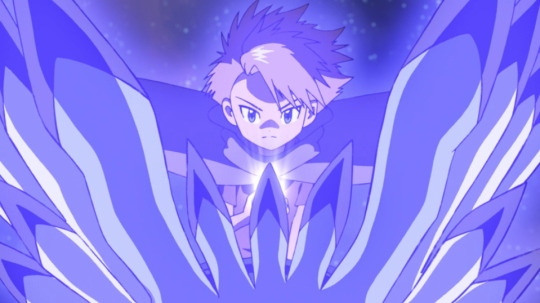
In this episode, all it takes is one ass thinking he’s better than everyone else to turn the whole team into a terrifyingly coordinated, efficient and effective invading army. Who knew?
Despite Koshiro and Kabuterimon taking their sweet-ass time getting into the Digital World, Yamato’s return binds the team together in a way that instantly makes it feel complete. It isn’t—some of these kids still have a lot to smooth out and Takeru and Hikari will complicate everything—but Yamato creates a tension that was sorely missing, rounding out the team and pulling everybody into their own unique corners. This is the first time the group dynamic feels sustainable through an entire series, and it doesn’t hurt that everyone gets to be a little awesome in a major team victory.
The episode’s premise and opening engagements promise greatness. An suspiciously convenient lighthouse shines a path to a fortress on an otherwise desolate shore. Tokyo has already started hoarding essentials expecting the worst. The hope of reaching the continent doesn’t blind the kids to the ominous tone going on here, and they’re rewarded with a sniper shooting down Ikkakumon. He and Birdramon think quickly to get everyone out of the drink safely, only to be greeted with a Tankmon assault and more sniping from the “lighthouse.” The overwhelming danger, the dark and misty night, and the lucky intervention they needed just to hide in a cave puts everyone’s backs to the wall. This is where we get to see character.
While Taichi had the fortune to meet Koshiro and Mimi in peak form, and could already vouch for Sora’s potential, Yamato meets the rest of the team rattled, recovering from the closest shave they’d encountered so far. They aren’t exactly Taichi itching to save the day and quick to befriend his new battle buddy. Rather than put his faith in the likes of Joe, Yamato insists a larger group makes for a larger target and that he should storm the castle himself. Gabumon thinks he’s trying to keep them safe. That’s cute.
In fairness, Taichi’s not sure what to make of it either. Is Yamato actually that dismissive of the team, trying to protect them without admitting it, or just being tsundere again and being a decoy without telling anybody? It takes Joe and a poorly received attempt at surrender for Taichi to realize he can return the favor and draw fire away from Yamato. Taichi and Sora charge in behind, arriving in time to take a DarkTyrannomon off Yamato’s hands, while Mimi and Joe run screaming as the Tankmon use them for target practice. It’s a simple strategy, one used many times before in the series, but they come to it organically, with plenty of clumsiness and indecision. They struggle to get to this point, making it more satisfying when everybody aces their tasks to achieve an outstanding success.
Simple and effective is also the best way to describe Yamato’s narrative this episode. While he still recognizes Taichi (and by extension Koshiro) as a useful ally, his preference is still to act on his own. And to be fair, it must have worked for him to not only get to this point, but scout the nature of the fortress and its guards. His revelation at the end is more gradual than it appears, first from Agumon and Piyomon jumping into a fight he perceived as a problem, Sora introducing herself as she follows her partner in battle. The pivotal moment comes as he reaches Gorimon thanks to Greymon running interference and leaving Gorimon unable to pick a target. That’s when he realizes everyone’s contributions, and that the victory he’s about to seal belongs to everybody. Being Yamato and all he doesn’t give a big speech about it, just a quick comment to Mimi, but it’s clear he recognizes the impact and the power they all have if he’d accept it.
Mimi’s not wrong though: Yamato did save the team. A couple episodes ago, it was a little too one-note, with not enough diversion and disagreement to be all that compelling. Joe helped a little, but Yamato provided the spark we needed, the bass line to round the song out and reinforce all the other sounds. Now everyone’s stepping up, where Sora’s role as Taichi’s second becomes vital and Mimi’s blunt honesty is impossible to ignore. There’s plenty more to do with these characters, but the show is exactly where it needs to be.
My Grade: A
Loose Data:
Mimi braiding Ikkakumon’s hair and her ire at Joe stealing her (actually Sora’s) towel is the sort of cute little throw-ins that we can continue to count on her to provide. It’s reminiscent of Eri or Astora providing amusing antics in the background of otherwise straightforward scenes in Appmon.
Sora quietly became the bearer of helpful observations this time around, questioning why there would be a lighthouse, showing concern over how quickly people in Tokyo are panicking, and recognizing that Yamato is a force to be reckoned with even on his own. She’s also bearing supplies again, which was mostly overlooked in the previous three episodes.
While the focus will be on the teamwork of our heroes, we should once again point out the intelligence in the enemy setup, creating a fortress to occupy a chokepoint beyond the beachhead. Gorimon using the Solarmon to both draw in and blind targets from a distance is the chef’s kiss.
Gabumon and Agumon are thrilled to see each other again, a nice callback to their pre-existing friendship in episode two. Although they seem to be more pleasant to each other in their Child forms than their Adult forms.
Piyomon once again gets denied an evolution sequence, as do Palmon and Gomamon, leaving the only sequences for Gabumon and Agumon (only the former’s is full-length). Honestly, given the pace of the episode, this left the episode with one too many sequences. I’m on board with only using them in plot-heavy moments.
See reviews of every Digimon episode at Digimon: System Restore! Support the site by joining our Patreon!
9 notes
·
View notes